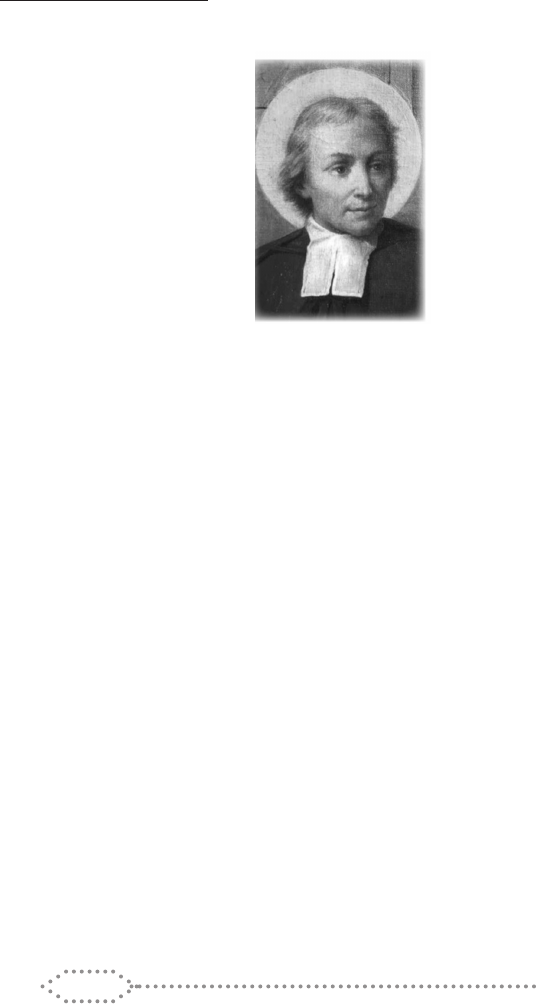
1
Part 1
INTRODUCTION
About the Founder
May 15
Saint John Baptist de La Salle
(1651 - 1719)
Founder of the Institute of the Brothers of
the Christian Schools
Patron of Christian Educators
Born in Rheims, France, on April 30, 1651, John Baptist
de La Salle completed seminary studies in Philosophy and
Theology, including the doctorate, and was ordained priest on
April 9, 1678. He overcame continuous opposition in founding
the Religious Institute of the Brothers of the Christian Schools to provide a human and
Christian education for the children of the artisan and the poor, who were deprived of such
an opportunity. He esteemed the teaching ministry to be so important that the Brothers
would not be tempted to abandon their primary ministry of teaching.
He developed, with the rst Brothers, revolutionary teaching methods in the use of
the vernacular language, the grouping and instructing of students according to ability and
achievement, the integration of human and Christian education, the systematic preparation
of teachers, and the involvement of parents. The institute he founded was the rst lay male
religious community in the Church. The Rule of the Brothers later served as a model for a
number of other teaching congregations.
After long years of heroic service, John Baptist de La Salle died on Good Friday,
April 7, 1719, in Rouen, France. He was beatied on February 19, 1888, and canonized on
May 24, 1900. On May 15, 1950, Pope Pius XII proclaimed Saint John Baptist de La Salle
the heavenly Patron of all Christian teachers.
January 26
Anniversary of translation of the relics of Saint John Baptist de La Salle, Priest,
Founder of the Institute of the Brothers of the Christian Schools, Patron of Catholic Teachers.
The relics of Saint John Baptist de La Salle were transferred several times. Initially,
they were moved from Rouen to Lembecq-les-Hals, Belgium, in 1906. Then from Belgium
they were transported to Rome, where they arrived on January 26, 1937, the anniversary
of the promulgation in 1725 of the Bull of Approbation of the Institute of the Brothers of the
Christian Schools. The relics are venerated in the Church of Saint John Baptist de La Salle
at the Generalate.
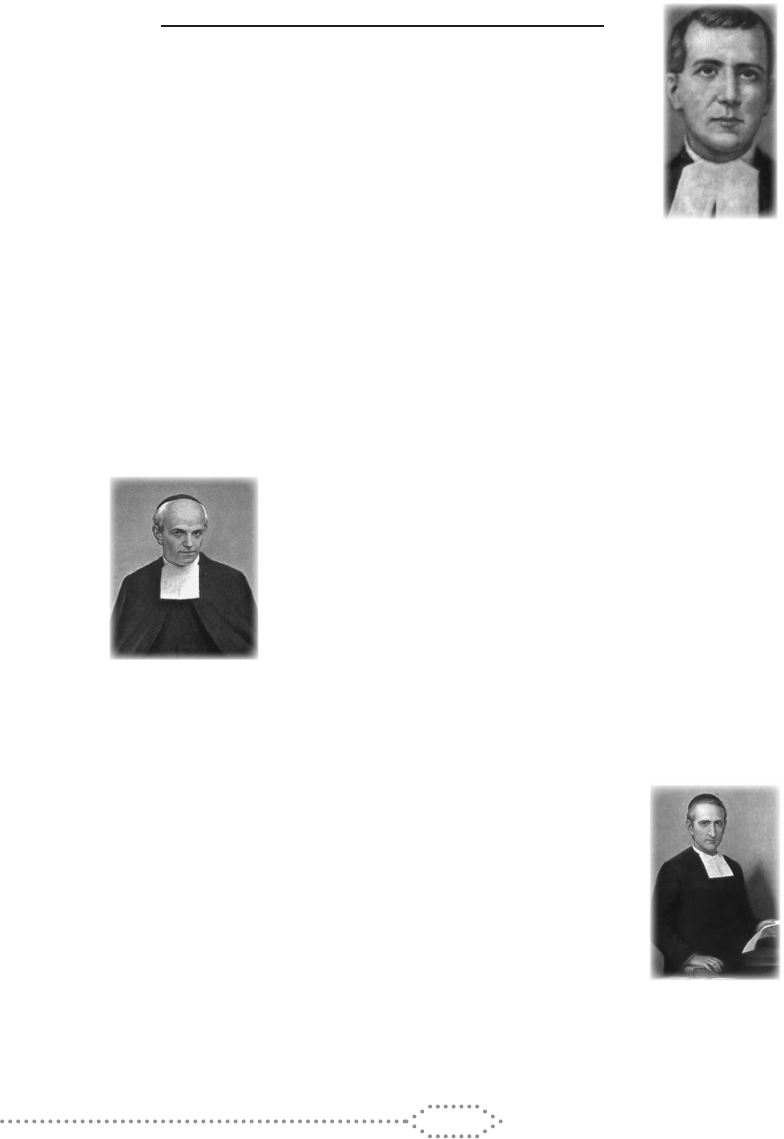
2
LASALLIAN SAINTS AND MARTYRS
January 18
Blessed Brother Jaime Hilario (1898 - 1937)
(Manuel Barbal Cosan)
Blessed Brother Jaime Hilario was born on January 2, 1898 in Enviny,
Diocese of Urgel, Lleida, Spain. He grew up in a Christian family atmosphere
in the countryside and in 1917 entered the novitiate of the Brothers of the
Christian Schools at Irun. He began his teaching and catechetical ministry at
Mollerusa, then in Manresa, Iliana, Pibrac (near Toulouse, France), Calaf and
Cambrils. At 28, he pronounced his perpetual vows.
At the outset of the Spanish Civil War, Blessed Brother Hilario was at Mollerusa.
On August 24, 1936, he was imprisoned at Lleida, and in December of the same year he
was transferred to Tarragona. Together with many other religious and lay people, he was
incarcerated at Mahon, in a ship transformed into a prison. On January 5, 1937, he was
given a summary trial. Three days later, he was executed in the forest called the Mount
of Olives, near the cemetery of Tarragona. His last words were. “To die for Christ, young
people, is to live”. He was beatied by Pope John Paul II on April 29, 1990.
January 30
Saint Mutien – Marie Wiaux (1841 - 1917)
(Louise – Joseph Wiaux)
Saint Mutien – Marie was born in Mellet, Belgium on March 20,
1841. Having joined the Institute of the Brothers of Christian Schools,
he dedicated himself for more than fty years to the education of
children in the Brother’s boarding school at Malonne, Belgium. To
his pupils, their parents and especially to his religious confreres, his
religious observance of the rule was worth emulating. He died at
Malonne, Belgium, on January 30, 1917. He was beatied by Pope Paul VI on October 30,
1977 and canonized by Pope John Paul II on December 10, 1989.
February 9
Saint Miguel Febres Cordero (1854 - 1910)
(Francisco Febres Cordero)
Francisco Febres Cordero was born on November 7, 1854 in
Cuenca, Ecuador. He was one of the rst students in the new school that
the Brothers opened in Cuenca in 1863. He received the habit of the
Institute of the Brothers of the Christian Schools with the name Brother
Miguel on March 24, 1868. After having taught literature and the natural
sciences, outstanding as a scholar and saint, he was also an epitome of
kindness and affability. The Academy of Ecuador named him one of its
members. Brother Miguel died at Premia de Nar, near Barcelona, Spain, on February 9,
1910. He was beatied by Pope Paul VI on October 30, 1977 and canonized by Pope Paul
II on October 21, 1984.
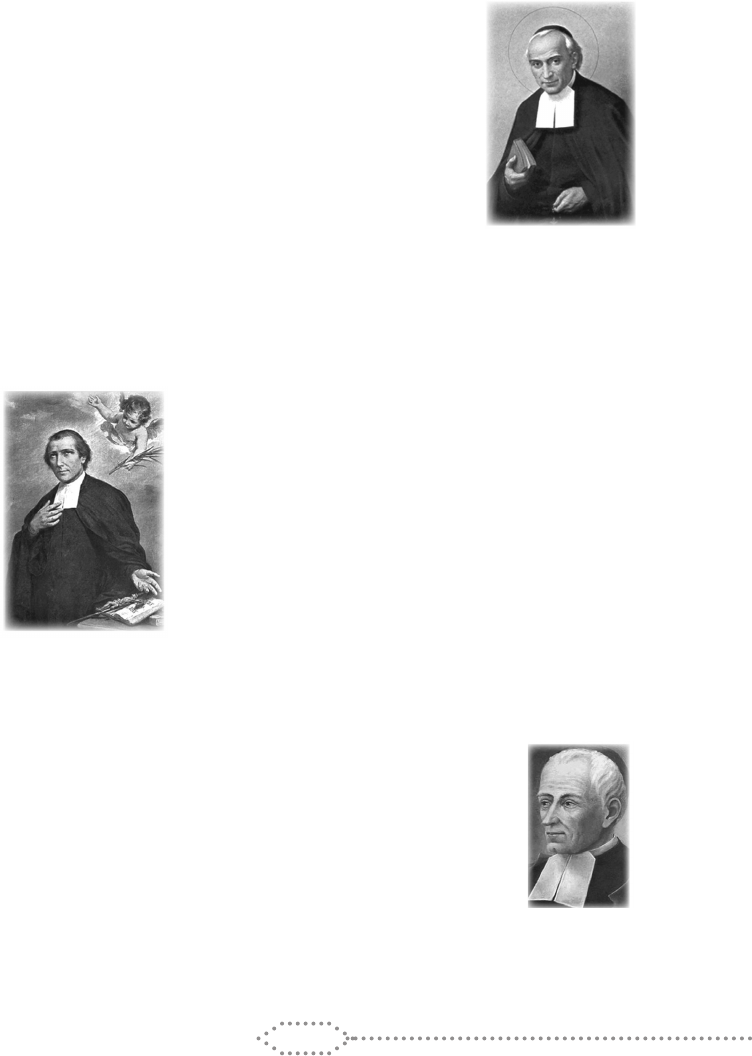
3
August 13
Saint Benilde Romancon (1805 - 1862)
(Pierre Romancon)
Pierre Romancon was born in the small village of Thuret,
near Clermont, France, on June 14, 1805. When he joined the
Institute of the Brothers of the Christian Schools, he was given the
name Brother Benilde and was assigned to teach children in the
primary grades. This was to be his sole task throughout his career
as a Brother. He took special pride in teaching catechism. Noted for
his spirit of prayer and charity, he had also distinguished himself by
showing great wisdom in leading his confreres and in counselling
both his Christian Living students and their parents. At Saugues,
where he lived for twenty-one years, he had the joy of aiding in
the development of numerous religious vocations. He died in Saugues, France, on August 13,
1862. He was beatied on April 4, 1958, and canonized on October 28, 1967.
September 12
Saint Brother Solomon Leclerq
(1725 - 1792)
(Nicolas Lecierca)
Born on November 15, 1745 at Boulogne-su- Mer, France,
Brother Solomon was a teacher, director, administrator, and
secretary to the Superior General. He always demonstrated a
great love for his students and diligent application of St. La Salle’s
teaching to his professional duties. The sanctity of his life shone
forth especially during the French Revolution, when he chose to
side with a group of priests who refused to swear allegiance to
the terms of the Civil Constitution. He was martyred on September
12, 1792 at the Carmelite Monastery in Paris. Brother Solomon
was beatied by Pope Pius XI on October 17, 1926.
April 13
Blessed Brother Scubillion Rousseau
(1797 - 1867)
(Jean Bernard Rousseau)
Born in Annay-a-Cote (Yvonne, France) in 1779, Brother Scubillion
joined the Brothers of the Christian Schools in 1822. He was sent in 1833
as a missionary to the island of Reunion in the Indian Ocean. There he
became known for his holiness and work as a teacher and a catechist
who promoted the cultural, moral, and religious development of the
slaves during the period of their emancipation. He died in 1867 in Sainte-Marie, Reunion,
and was beatied by Pope John Paul II on May 2, 1990, in Reunion.

4
THE BROTHERS OF THE CHRISTIAN
SCHOOLS IN THE PHILIPPINES
The Brothers rst came to the Philippines in 1911, when they were invited by the
Archbishop of Manila to set up a Catholic school for the children of the upper class in the
country’s capital. The Bishop was concerned then about the growing number of American
Protestant schools in the country that he sought the help of the Brothers to stem the tide of
this growing inuence among the children of the country’s leading families.
Although the Brothers found themselves in a situation where they were providing
education for the children of the elite, they endeavored to remain true to their mission by
inculcating in their students a deep concern for the plight of their less privileged countrymen.
It was hoped that their Lasallian education would encourage them to utilize and develop
their talents and their resources in serving the nation, as they were bound to succeed their
fathers in taking the helm of the Philippine economic, political, and cultural life.
As the Brothers in the Philippines grew in number, as their resources allowed, they
gradually established more La Salle schools directly serving the needs of the poor and
underprivileged through education in the country.
Today, to be more efcient and effective in the implementation of the Lasallian
Mission, the Brothers of the Christian Schools established a network of 17 Lasallian schools
known as De La Salle Philippines (DLSP) comprising the following District Schools:
LUZON
• De La Salle – College of St. Benilde
• De La Salle Health Sciences Institute
• De La Salle Araneta University
• De La Salle University Science Technology Complex-Laguna (DLSU Satellite
Campus)
• De La Salle Lipa
• De La Salle Santiago Zobel School
• De La Salle University – Dasmariñas
• De La Salle University – Manila
• Jaime Hilario Integrated School-La Salle
• La Salle College Antipolo
• La Salle Green Hills
VISAYAS
• De La Salle Andres Soriano Memorial College
• St. Joseph School – La Salle
• University of St. La Salle
MINDANAO
• De La Salle John Bosco College
• La Salle Academy-Iligan
• La Salle University

5
De La Salle Philippines
VISION – MISSION
PREAMBLE
Deeply moved, as St. John Baptist De La Salle was, by the plight of the poor and
youth at risk, we, the members of the Lasallian Schools in the Philippines, commit ourselves to
the Lasallian Mission of providing a human and Christian education to the young, especially
in schools, with the service of the poor as priority, in order to evangelize and catechize,
to promote peace and justice, accomplishing these together as shared mission. We draw
strength from the many Lasallians committed to incarnating our charism in our country today
to serve the needs of Filipino youth, especially those at risk.
DECLARATION
Inamed by the Holy Spirit, God’s own Fire, we declare our commitment to the
following:
• We shall work together as a national network of Lasallian schools in the Philippines
for the efcient and effective implementation of the Lasallian Mission, following
the directives of the De La Salle Brothers and the Philippine Lasallian Family as set
by the General Chapter, the District Chapter and the Philippine Lasallian Family
Convocation.
• We shall ensure the integrity of the Lasallian Mission by setting directions and
standards applicable to the Philippine Lasallian schools and by monitoring their
implementation.
• We shall promote the Lasallian Mission by fostering synergy, collaboration and
sharing among the Lasallian schools.
• We shall uphold the Lasallian values of faith, zeal in service and communion in
mission.
PRAYER
In all these, we together and by association, dedicate our life and work to God,
Who alone guarantees the fulllment of our Lasallian dream.
Charism
FAITH
• We need to believe in a loving God.
• Believe that we have been called by this loving God.
• That we are called and gifted by God to be of service to others in the ministry
of Christian education.

6
REVITALIZATION / ZEAL
• Generate creative ways of serving youth-at-risk
• Attend to the promotion of justice, peace and the integrity of creation.
• Attend to evangelization/pastoral action in and out of our institutions.
• Push educational innovation in the service of the integral human/ Christian
development of students.
ASSOCIATION FOR MISSION / COMMUNION
• Associates share the same vision and spirit.
• They are involved in mutual collaborative ministry.
• All involved in this ministry are gifted and talented; we need to identify, release
and utilize these gifts.
• We need to create genuine ministerial communities where gifts can be afrmed,
released and utilized for the sake of the mission.
THE INTEGRATED SCHOOL
VISION MISSION AND OBJECTIVES
Vision: The USLS-IS is a Catholic, Filipino, co-educational private school administered
by the La Salle Brothers and Lay Educators. It envisions a school community as an instrument
of evangelization towards the process of achieving total human salvation.
Mission: It commits to the formation of Christian values and pursuit of relevant
education for life. As a school community, inspired by the charism of St. John Baptist de La
Salle, it seeks that each member of the community will:
1. instill and nurture spiritual and moral responsibilities
2. enhance intellectual and physical potentials
3. develop emotional and social maturity
4. cultivate concern and service for the Church of the poor
5. act as responsible steward of God’s creation
6. take pride of being a Filipino
7. live the Lasallian Heritage
DEFINITION OF TERMS
In order to better understand the vision, mission and objectives of the Integrated
School, some phrases have been dened:
1. Agent of Evangelization
Evangelization in the Lasallian school is the work of the whole school community,
since everything the school community does fosters the authentic development

7
of persons under its power, which leads them to become more like Christ. The
Lasallian school offers young people the opportunity to live with others the gospel
message they are taught. It offers a powerful experience of a Christian community
precisely because it strives to be one; it is where the Gospel is proclaimed through
the witness of life.
2. Church of the Poor
It means a church that embraces and practices the evangelical spirit of profound
trust in the Lord as sole source of salvation. While the Lord does not want anyone
to be materially poor, he wants all his followers to be “poor in spirit.”
3. Formation of Christian Values
Curriculum includes values integration in all subject areas, Christian Living
instruction, campus ministry and social programs provided to indicate and
form students to live the gospel values.
4. Integral / Total Human Salvation
The goal of Lasallian education is to enable students to make real in their
lives the gift of salvation in Christ by enabling them to live by the Christian
spirit in their particular context, contributing to the fulllment of God’s reign
of justice, love, and peace through their work in the world. Salvation in Christ
is progressively realized in the Lasallian school through an educational project
that takes into account all aspects of human development in its reorientation
towards Christ who is the paradigm of the human person liberated from sin
and made new.
5. Lasallian Heritage
The founder’s life story, charism, and spirituality, Lasallian Vision – Mission,
Philosophy of Lasallian Education embody the Lasallian heritage.
6. Relevant Education for Life
Lasallian education is an education for life. It seeks to prepare young people
for responsible participation in the world of work, in the family, in the
community, and wider society. It strives to prepare them to face actual life
situations with integrity and competence.
Thrust
ONE IN LASALLIAN FAITH
COMMITTED TO SERVICE & EXCELLENCE
One in Lasallian Faith
Faith is a fundamental virtue to a Lasallian community. Through this charism, the light
of the Gospel pervades the hearts and minds of all Lasallians enabling them to discern
God’s will in whatever circumstance they are in and to afrm that the act of coming together
is a manifestation of God’s intervention.

8
Committed to Service and Excellence
Lasallian education is marked by zeal. All strive to be of service to others by
expressing concern and compassion for the plight of the poor and marginalized sectors of
society and by responding to their needs.
Lasallian education transforms distinct individuals who take the progressive
responsibility for their own continuous learning and development.
It impels learners to translate their knowledge into actual practice for the
betterment of society. It prepares individuals to be responsible participants in life.
HISTORY OF
THE USLS-INTEGRATED SCHOOL
The rst group of Brothers, nine in numbers, arrived in Manila in 1911 upon the
invitation of the Archbishop of Manila to establish a college of standard. Paco was the
original site of the Brothers’ rst school, and later, in 1921, a new building was erected on
the present site at Taft Avenue. From this modest beginning the pioneer effort of the rst
La Salle Brothers developed until at present. There are eighteen (18) District Schools and a
number of La Salle supervised schools throughout the country.
The La Salle Brothers came to Bacolod City in response to the ardent invitation of
the Negrense who felt a great need for the type of education the Brothers were offering.
Through a ten - hectare donation of the late Mr. Alfredo Montelibano, Sr., La Salle -
Bacolod came into existence.
In July 1952, with 189 graders ranging from Prep to Grade 5 and a teaching force
of seven, La Salle College - Bacolod formally opened. Three of the faculty members were
Bro. Dennis of Mary, Bro. Hugh Wester and Bro. V. Felix Masson and the fourth Brother, Bro.
Gratian of Mary, joined in September of same year. The following year, grade 6 was added.
During the school year 1952 - 1953, the parents requested for the opening of the
high school department. On February 9, 1952, cement footings were poured for the rst
high school wing.
Classes opened in 1953 with 24 freshmen, all males. At rst, the Brothers accepted
student - boarders, there were 56 of them under the supervision of Bro Gratian Murray.
The present laboratory and lecture hall served as their sleeping quarters and study hall.
In its second year of operation La Salle had 453 boys in the three edging
departments.
School year 1977 -1978 marked the Silver Jubilee of the founding of La Salle -
Bacolod. Numerous activities were scheduled to commemorate ttingly the foundation. In
1978 the Grade School received its PAASCU Accreditation, the High School received its
Accreditation in 1980.
At the end of the school year 1984 - 85, the institution decided to place under one
administration the elementary and secondary levels to compose basic education program

9
for La Salle - Bacolod, thus the birth of the La Salle - Bacolod Integrated School.
The effort was a practical move since it was felt that the elementary and secondary
levels should progressively and interruptedly form one continuum. Such move would be for
the overall betterment of the students’ education.
Since 1986 La Salle has accepted as part of its clientele, Kinder and Prep Girls. It
was not until 1987, however, that the Board of Trustees ofcially handed its decision to turn
coed both the grade school and the high school. The inclusion of girls in the once exclusive
school for boys has not drastically changed the school’s mission statement. The school’s
objectives remain basically the same. However, changes have been made regarding
the manner by which these objectives are attained. In a nutshell, the objectives can be
summarized into: 1) holistic development, 2) social awareness and involvement, 3) academic
excellence, 4) concern for the poor, 5) love for one’s country and being a Filipino.
The succeeding events constitute the milestones of the Integrated School:
July 5, 1988
• Elevation of La Salle College to university status through the effort of Bro.
President Rafael Donato, FSC who initiated it in 1982, continued by his successor
Bro. Victor Franco, FSC (university President 1983-1986) and completed by Bro
Rolando R. Dizon FSC (University President 1986-1998) .
• The University of St. La Salle became the rst institution to be elevated as a
university after the EDSA revolution and also the only one under President
Corazon Aquino’s administration.
June 1994
• A three-storey high school building was erected, totally separated from the
college department.
1997
• Both Elementary and High School levels were granted 3rd reaccreditation
status by PAASCU.
2002
• Both elementary and high school levels were granted 4th accreditation status
by PAASCU.
• On July 5, 2002, the University of St. La Salle celebrated its 50 years of
existence in Negros with the theme, “Keeping Faith”.
2005
• After the retirement of Dr. Myrna Juplo in 2005, a new principal was appointed
in the person of Mrs. Ma. Del Pilar M. Limas.
2007-2008
• Br. Ray B. Suplido, FSC PhD became the 10th President of USLS.
• In February 2008, Br. Felix Masson, FSC, one of the Founding Brothers of La
Salle Bacolod passed away in California, USA.

10
• On August 3, 2008, the Papal Nuncio visited the University. The Integrated
School was very much involved in welcoming the Papal Nuncio on this rare visit
to the school.
• On September 8-9, 2008, the PAASCU Resurvey Team visited the Integrated
School. The school underwent the rst Basic Education Accreditation. The school
was granted a “clean” re-accredited status for a period of ve years. This was
an afrmation that the school has successfully accomplished its Vision - Mission
for the school.
2008-2009
• Over the years the Integrated School won several academic, cultural, sports
and non - academic awards. The most prestigious of these commendations was
the 2008 -2009 National Achievement Test among the 56 private and public
secondary schools in the Division of Bacolod City. Batch 2010 - 2011 ranked
Number One. The same rank was obtained by the school in the 2009 - 2010
and 2010 - 2011 National Achievement Test respectively.
2011-2012
• The Christian Brothers of the La Salle Schools celebrated their CENTENNIAL YEAR,
ONE HUNDRED YEARS of Lasallian presence in the Philippines. The Integrated
School actively participated in all the activities the whole year round.
• In July 2012, the University of St. La Salle celebrated its DIAMOND Jubilee with
the theme, “Transforming Lives. Building Communities. Shaping Futures.”
November 22, 2013
• PAASCU granted the Integrated School another “clean” ve-year re-accredited
status after the second Basic Education Accreditation on September.
2014-2015
• Ms. Doris H. Dumaran was appointed the new principal of the Integrated
School succeeding Mrs. Ma. Del Pilar M. Limas.
• As part of the Handumanan Week celebration, the groundbreaking of the
future site of the Integrated School, the Alunan Campus in Brgy. Mandalagan
was conducted on July 8, 2014.
2015-2016
• Br. Manuel “Mawel” R. Pajarillo, FSC PhD became the 11th President and
Chancellor of the University. This year marked the 63rd founding anniversary
of Lasallian presence in the Negros Island with the theme “Burn with the
Brightest Flame”.
• With Br. Mawel’s administration many changes were introduced in view of his
Strategic Directions including Spirituality and Sustainability, Creativity and
Technology, and Internationality and Inclusion.
2016-2017
• A remarkably glorious year for the Integrated School with all the exemplary

11
performances and achievements of the students one after the other in almost
all elds:
- academic competitions such as the Rotary Academic Excellence Contest
and the Mathematic Association of the Philippines (MTAP)
- culture and the arts such as NOPSSCEA Literary-Musical and Dance fests
- campus journalism in the division, regional and national levels
- sports competitions and related events in the NOPSSCEA, provincial.
Regional, and Palarong Pambansa
- student leadership and community service through Rotary’s Boys and Girls
Week with IS student leaders as Boy Mayor and Girl Vice Mayor,
- Search for Three Outstanding Students (THOS) and Three Outstanding
Student Councils (TOSCA) awards
- student and faculty international benchmarking and leadership camps
• The Integrated School hosted the 3rd DLSP Basic Education Commission
Academic and Cultural Fair attended by La Salle Schools all over the country.
2017- 2018
• The Integrated School welcomed more challenges with the 12th President/
Chancellor of the University, Br. Joaquin Severino “Br. Kenneth” F. Martinez,
FSC, DMin who takes the lead in the advancement of the university thrust this
academic year: “Living out the Lasallian Values in our Educational Mission
Today”.
• Introduction of the Philippine Catholic Schools Standards (PCSS) through series
of seminar-workshops involving the IS administration, faculty and staff; IS PCSS
teams started initial self-assessment
2018- 2019
• 3rd PAASCU Basic Education Resurvey on September 3-4, 2018 which earned
the Integrated School a 5-year accreditation status valid until November 2023
• 1st IS Animofest (Literary-Musical Intramurals)
• The Integrated School received approval of its application for Education
Service Contracting (ESC) grant by the Private Education Assistance Committee
(PEAC) with initial 110 slots for incoming Grade 7 students. This was made
possible through the efforts of the IS Principal, Ms. Doris H. Dumaran.
• First batch of USLS-DLSU Master of Learning and Teaching (MALT) teacher-
scholars funded by the university with 50% scholarship from DLSU Manila as
pilot faculty development project of Br. Kenneth Martinez FSC
• PAASCU Accreditors Training was held in the Integrated School on January
31-February 1, 2019.
• The Br. O’Neill Building which used to house Grade 4-7 classes was demolished
to give way to the construction of the new IS Building. Affected Grade 4-6
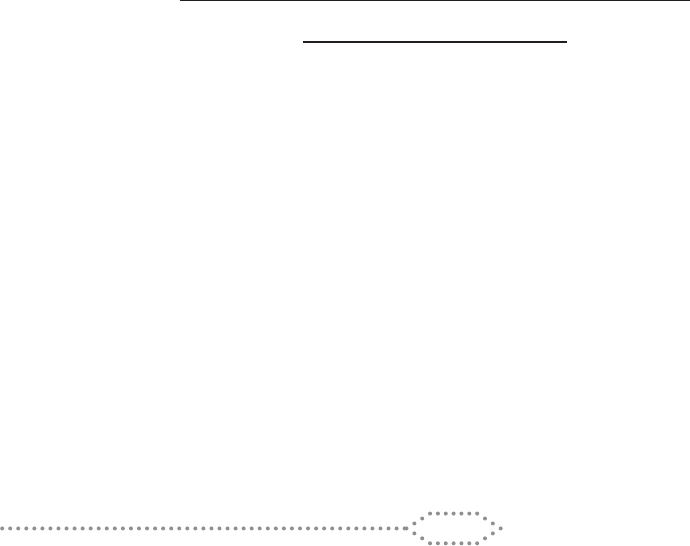
12
classes momentarily transferred to Santuario De La Salle (converted into
classrooms) with 3 additional temporary classrooms adjacent to Parmenie
house while Grade 7 classes were temporarily held at the 2nd and part of 3rd
levels of St. Miguel Building (Liceo SHS building) and are to remain there until
the new IS building will be ready for occupancy.
• Groundbreaking ceremony for the new IS building which will house Grades
4-10 classes by June 2022
2019- 2020
• This school year the Integrated School welcomes its new Brother Principal, Br.
Francisco “Sockie” V. Dela Rosa VI FSC, succeeding Ms. Doris H. Dumaran who
takes her retirement effective June 2019.
• Br. Sockie also serves as the concurrent Principal of Liceo De La Salle Senior
High School, promising a signicant leap in the eventual assimilation of the
Integrated School and Liceo.
• Construction of the new IS Building is ongoing.
As all these continue to unfold, the Integrated School remains to be a Christ-centered
basic education community rooted in the Gospel values and the charism of the Founder,
St. John Baptist De La Salle. It commits to live the foundational values of “Faith, Zeal for
Service and Communion in Mission “as it endeavors to ‘Teach Minds, Touch Hearts and
Transform Lives” of the young entrusted to its care.
PRINCIPLES OF LASALLIAN EDUCATION
IN THE PHILIPPINES
Lasallian schools are educational communities where all sectors. . .
• participate in the Church’s mission and are committed to easing the plight of
the vulnerable and marginalized sectors of Philippine society;
• are committed to assuring the integral human and Christian development of
learners in all their uniqueness and diversity;
• are co-responsible for creating a culture and climate conducive to genuine
learning and character formation;
• are stakeholders who work in association with one another in a strong spirit of
fraternal solidarity; and
• are committed to continuous renewal and transformation in collaboration with
others to accomplish their common mission.
Lasallian learners are unique and gifted individuals who…
• • strive to integrate Gospel perspectives and values in the conduct of
their daily lives;
• are committed to excellence in order to be of greater service to God and

13
country;
• take progressive responsibility for their own learning and development;
• express concern and compassion for the plight of the vulnerable and
marginalized sectors of society and respond to their needs; and
• work together creatively, constructively, and enthusiastically to support the
Lasallian Mission.
Lasallian educational experiences are dynamic processes that…
• challenge learners to realize their full potential by promoting critical and
creative thinking, self-knowledge and self-mastery;
• bring Christian perspectives and values to bear on human knowledge and
culture;
• encourage synergy, collaboration and dialogue in an environment that is
fraternal, hospitable and laden with mutual respect;
• impel learners to translate their knowledge into actual practice for the
betterment of society; and
• prepare learners for responsible participation in the world of work, the family,
the community, the wider society and the local Church
LASALLIAN ATTRIBUTES
The qualities of a true Lasallian graduate are exemplied in the following Lasallian
attributes:
Christian Gentleman/Lady
1. Is courteous in relating with
a. members of the school community: faculty, staff, fellow students
b. parents, members of the family and household helpers
c. others, especially those who have less in life
2. Shows proper behavior in all kinds of gathering, assemblies and social
functions: religious/spiritual, eldtrips and outreach activities
3. Manifests clean fun and does not use foul language
4. Respects the dignity of peers and others
Commitment to Excellence
1. Comes to class well- prepared
2. Submits quality work and requirements on time
3. Strives to do more than what is expected
4. Takes extra effort to further improve one’s skill or ability
5. Listens and takes feedback to improve one’s work

14
Pride in the Filipino Heritage
1. Participates actively during the ag ceremony
2. Shows interest and keeps abreast of Philippine local and national affairs
3. Patronizes Filipino products
4. Shows pride in being a Filipino
5. Observes Filipino practices, culture and traditions
Caring for the Earth
1. Observes Clean As You Go (CLAYGO) policy
2. Observes the proper waste management: Reuse, Reduce, Recycle
3. Uses school materials and household facilities wisely and efciently
4. Helps in the general upkeep of the school, home and environment
Contributing to Society
1. Abides by the rules, policies and regulations of the school and home
2. Participates actively in group and class activities
3. Engages in worthwhile and productive habits, hobbies and activities
4. Observes environment – friendly practices
5. Performs assigned task with responsibility and discipline
6. Deplores/ avoids activities that will endanger oneself, the name of the school
and one’s family
Competence
1. Participates in opportunities to be able to use one’s skill and ability
2. Manifests creativity, innovativeness and resourcefulness
3. Shares one’s talent / ability with others
4. Gives one’s best on whatever endeavor one undertakes
Concern for the Marginalized
1. Gives generously during the mission-collection and relief operations
2. Involves in service-oriented organizations/activities
3. Relates well with those who are needy and lower in rank sectors of society
Condence
1. Believes in one’s goodness and capacity to do things right
2. Accepts one’s limitations and difculty and works to improve oneself
3. Displays a positive outlook and attitude in life
4. Speaks for what one believes in though it may not be popular to others

15
5. Carries and conducts oneself well
Compassion
1. Understands the needs and feelings of peers/ others
2. Helps without being asked
3. Gives time to listen and gives encouragement to peers/ others
4. Shows consideration and forgiveness of other’s shortcomings
Leadership
1. Takes initiative in group work/ undertaking
2. Shows respect for peers, teachers and siblings
3. Encourages participation in doing group work
4. Sets good example in the conduct of one’s daily activity
Lasallian Prayers
PRAYER OF A LASALLIAN
Father in Heaven, God of love,
All I am and have is Yours.
Grant that I may become
A living sign of your compassion in this world.
Grant me the faith to live my life
Always in the awareness of your loving presence.
Grant me the zeal to serve,
Without the thought of reward,
Those to whom You send me.
Grant me the charity
To bear the burdens of my brothers and sisters
Teach me to seek Your Son’s face
In the last, the lost, and the least.
In whatever I undertake,
May I seek above all things
To procure Your glory
As far as I am able,
And as You will require of me.

16
Strengthen me by Your Holy Spirit
To follow Jesus
By living the commitment
I make this day.
Amen.
I will continue oh my God to do
all my actions for the love of You
Saint John Baptist de La Salle.
Pray for us.
Live Jesus in our hearts
Forever!
ONE LA SALLE PRAYER
Lord,
Let me be the change I want to see
To do with strength and wisdom
All that needs to be done
And become the hope that I can be
Set me free from my fears and hesitations
Grant me courage and humility
Fill me with spirit to face the challenge
And start the change I long to see
Even if I’m not the light
I can be the spark
In Faith, Service and Communion
Let us start the change we want to see
the change that begins in me
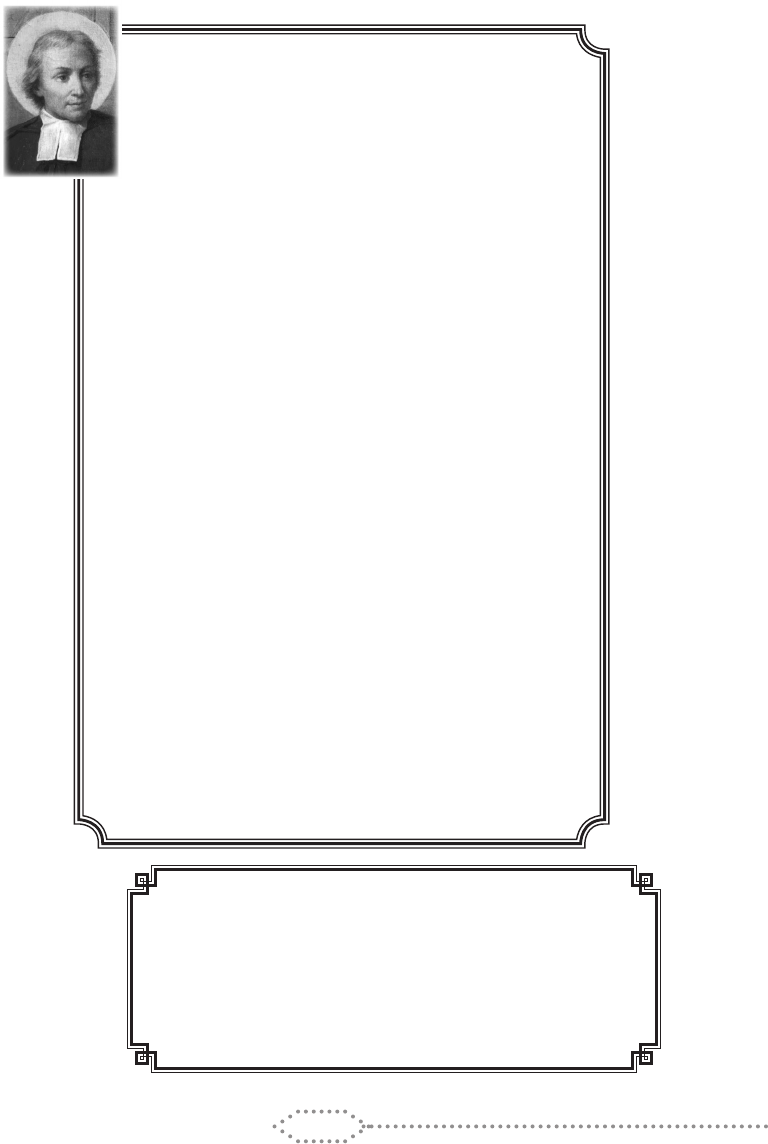
17
PRAYER AT THE END OF THE DAY
The day is over, O Lord, and I commit its failures
As well as its successes into your hands.
I rejoice in your tender care and celebrate your loving presence.
I pray that you will heal the wounds of those I have hurt.
I place in your care those I love most
And those through whom you ministered to me this day.
Bless them and keep them and ll their lives with joy.
I pray that you may somehow reach those whom
I couldn’t love or cause to feel my love
That other faithful servants of yours
May convey your concern for them.
Grant that I may truly learn how to love
as you love me.
And demonstrate that love to the lonely, the sick,
The despairing, the poor and the neglected people along my path.
This day is over, O Lord,
Its blessings and conicts and disappointments.
If it is within your will, grant me another day,
And help me to live in your strength
and according to your plan.
For the sake of Jesus Christ our Lord, Amen.
St. John Baptist de La Salle… Pray for us.
Live Jesus in our hearts… forever.
I will continue oh my God to do all my actions for the love of you.
Saint John Baptist de La Salle.
Pray for us.
Live Jesus in our Hearts.
Forever!

18
Lasallian Songs and Cheers
ALMA MATER HYMN
Hail, hail Alma Mater
Hail to De La Salle
We’ll hold your banner
high and bright
A shield of green and white
We’ll ght to keep your glory bright,
And never shall we fail
Hail to thee our Alma Mater
Hail, Hail, Hail
WHO’S TO WIN THIS GAME
Who’s to win this game, set! 1-2-3!
Who’s to win this game? GREEN!
Who’s to win this game? WHITE!
GREEN! * GREEN!
WHITE! * WHITE!
* GREEN, WHITE, FIGHT!
GREEN, WHITE, WHITE, WHITE!
*GO, FIGHT, FIGHT, FIGHT!
* GREEN, WHITE, FIGHT!
* GO, FIGHT, FIGHT, FIGHT!
* DE LA SALLE! DE LA SALLE!
* FIGHT TEAM, FIGHT
*CROWD
REKTIKANO
Rektikano, set! 1-2-3!
Rektikano!
*Rektikano!
Ready!
Ready!
1-2-3!
Rektikano, Keennee-keena! (2x)
Rektikano, Rektikano,

19
Rektikano! Rah (2x)
Seez-Boom-Bah! (2x)
Boom-Rah-Boom-Rah
Boom-Rah-Rah (2x)
Seez-Boom-Bah
Seez-Boom-Bah!
La Salle, Rah!
*Crowd
ZAMA ZIPA ZAM
Zama Zipa Zima, Set! 1-2-3!
Zama Zipa Zim!
Ready!
Ready!
1-2-3!
* Zama Zipa Zam
(1-2, 1-2-3, 1-2-3!)
* Zama Zipa Zam
(1-2, 1-2-3, 1-2-3!)
*FIGHT!
(Repeat 3x)
WIN, TEAM, WIN!
LA SALLE SPELLING
La Salle spelling, set! 1-2-3!
La Salle spelling!
La Salle spelling!
Ready!
Ready!
1-2-3!
*L-A-S-A-L-L-E
La SALLE, RAH!!!!!
*CROWD

20
Part 2
GENERAL INFORMATION
I. ADMISSION INFORMATION AND REQUIREMENTS
A. Admission Procedures and Requirements
1. Applicant or a representative enlists with either Grade School or Junior
High School Guidance Center by providing the following information:
• Name of Student Applicant
• Grade Level Applied For
• School of Origin
• Date of Birth/ Current Age
• Contact person
• Mobile/ Telephone Number
2. Guidance in-charge issues pre-numbered Admission Payment Slip
(APS) print out.
3. Applicant or a representative proceeds to Accounting Ofce, submit
APS to cashier for payment. Cashier issues ofcial receipt for payment
received and returns APS marked “paid” to applicant.
4. Applicant or representative presents ofcial receipt marked “paid”
to the Guidance in-charge for issuance of Admission Kit containing
requirements/ documents to be accomplished and submitted before
scheduling the Integrated School Entrance Exam (ISET).
5. Exam permit is issued after the applicant has submitted all the required
admission documents. Entrance test is scheduled in accordance with the
assigned date of examination per grade level by the Guidance Center
on a rst come, rst served basis.
6. Applicant is scheduled for interview by the Level Vice Principal or any
member of the Admissions Board.
7. The results of the entrance exam, interview and other pertinent
documents of the applicants are deliberated by the Admissions Board
and released through an ofcial letter from the Guidance Services
Center.
Inquiry of result by phone call is not entertained.

21
B. Admission Requirements
For NEW STUDENTS and TRANSFEREES
The applicant must:
1. accomplish the following documents required by the Guidance Services
Center:
a. Application Form
b. Letter of Recommendation (form provided)
c. Certied copy of Form 138 (Report Card)
d. PSA Birth Certicate (2 pcs. photocopy)
e. 2 pcs. 2x2 ID pictures
2. have satisfactory marks in all subjects ;
3. have a satisfactory deportment grade;
4. be within the age group of the grade level one is applying for;
5. successfully pass the criteria set by the Admissions Board.
For KINDER
a. Must be 5 years old by June 1 (Those who will turn 5 by the
end of August may still be reconsidered upon compliance of other
requirements that may be asked)
b. Must have completed a pre-kindergarten schooling or its equivalent
For FOREIGN STUDENTS
a. Certicate of English Prociency (for non-English speaking students)
b. Foreign Passport/Philippine Passport (for Balikbayans)
c. DepEd Certicate of Placement (to be taken from DepEd ofce)
For RETURNING STUDENTS
a. A student who was asked to withdraw from school for academic
reason may be re-admitted after a year of studies on condition that:
1) academic performance from other school of least an average of
85 percent; 2) a satisfactory deportment grade; and 3) satisfactory
admission test result.
b. A student who voluntarily withdraws from USLS-IS for disciplinary
reason may re-apply for admission provided the student has: 1) a
satisfactory deportment grade; 2) a good academic performance from
previous school; and 3) pass the admission test. The application will be
subject to the evaluation of the Admissions Board. Previous IS records
of performance in both academic and deportment are considered vital
in the evaluation of the returnee-applicant.
C. ENROLLMENT PROCEDURES
For NEW STUDENT and TRANSFEREES
a. Submit the following requirements to the enrolling ofcer:
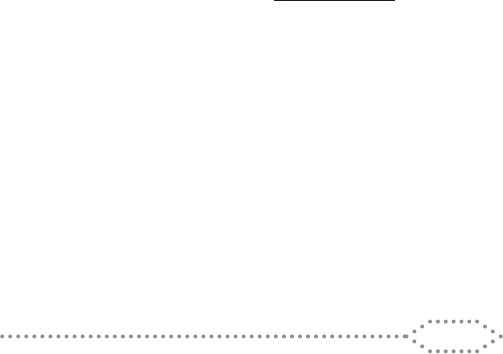
22
• Accepted letter from the Guidance Services Center
• A photocopy of PSA Birth Certicate
• Original Report Card
• Alien Certicate of Registration (ACR) or Special Study Permit
(SSP) for accepted FOREIGN student
• Filipino Recognition Certicate or Philippine Passport for a student
with DUAL citizenship
b. Fill out the Enrollment Form. Duly accomplished form will be stamped
“For Payment”.
c. Present the Enrollment Form duly signed by the enrolling ofcer to the
Business Ofce for payment.
Note: Limited slot is available for each grade level. A new student who fails
to enroll on the scheduled dates of enrollment for transferees may
lose the slot in favor of a student on the waitlisted status.
FOR CONTINUING STUDENTS
a. Present the report card to the enrolling ofcer
b. Fill out the Enrollment Form. Duly accomplished form will be stamped “For
Payment”.
c. Present the accomplished Enrollment Form duly signed by the enrolling ofcer
to the Business Ofce for payment.
II. ATTENDANCE POLICY
A. SCHOOL ATTENDANCE
1. According to the DepEd Policy, a student who incurs 20% or more absences
of the total number of school days will be withdrawn from school.
2. Absence due to illness, although duly certied by the doctor, is not
considered an excused absence and shall therefore be added to
the student’s total number of absences. The teacher, however, has
the discretion to give special consideration by giving make-up tests,
quizzes, special projects, etc.
3. An excused absence is an absen c e from class that is of cially sanc tioned
by the school, such as attendance in an off campus sponsored seminar,
joining contests during class hours, etc. An excused absence will not be
added to the student’s total number of absences.
4. A student is considered tardy when he/she comes to the classroom after
the nal bell has rung (morning/afternoon sessions) or when he/she
arrives during the second period. If a student arrives during the third
or fourth period, he/she is considered half day absent. If he/she arrives
during the last two periods in the afternoon, he/she is considered absent.
5. After breaks or in-between periods, students who are not inside the
classroom by the time the teacher closes the door shall be considered late.
Unexcused tardiness will merit the following deportment grades:

23
1 ………………………… Warning
2 ………………………… A-
3 ………………………. B+
4 ………………………. B
5-6 …………..…………. B-
7 and above …………… C
If a student is late, he/she proceeds to the Ofce of the Discipline and
Formation Ofcer or Level Vice Principal and gets an admit slip. This is
presented to the Homeroom Adviser or subject teacher.
6. Double absence will be recorded on the attendance records of students
who are unnecessarily absent from school during the following occasions.
a. Before and after a declared holiday or its equivalent
b. For the duration of the Sportsfest or its equivalent
c. As announced by the Principal
7. A student is held responsible for all assignments and for the entire
content of topics missed, regardless of the reason for the absence. The
teacher, however, has the discretion to give special consideration by
giving make-up tests, quizzes, etc.
B. FREE DESIGN DAY
Any class that accumulates 20 days of perfect attendance and punctuality
(PPA) is entitled to a Free Design Day. Additional star/s may be earned by a
class based on Class Spirit credits or merits. The class may plan out activities
for a particular day chosen by the class and the homeroom adviser.
* A student is ONLY allowed to bring educational toys in school during
FREE DESIGN DAY. Bicycles, skateboard, roller blades, gadgets for
gaming and the like are not allowed.
III. GROOMING/ UNIFORM POLICY
A. GROOMING
For purposes of security, safety, unity and prudence, all students are expected
to cooperate with the grooming guidelines. Clean, short, unpolished nails,
well-combed hair, shined shoes and the prescribed uniform must be properly
worn.
To ensure the students’ safety and security, only appropriate jewelry
for school wear is allowed such as one set of earrings (no dangling) for girls
and wrist watches for the boys and girls. General grooming inspection will be
conducted randomly by DFO and the homeroom adviser/subject teacher.
Not Allowed:
• Applying of body tattoos or marks on any parts of the body
• Applying of colored hair dye, wearing of earrings for boys
• Use of colored lenses, bracelets, anklets, ballers, rings and the like, other
expensive jewelries

24
• Use of caps or hats inside the high school building, nail polish, make-up
and the use of punk hairdo and accessories on campus
• Bringing a big amount of money and expensive gadget in school
B. HAIRCUT REGULATION
For Boys:
The regulation species that the hair should not cover the eyes and ears and
should not exceed the collar. The sides and the back should have the “sliding
cut” and not a “box or corner cut”. The “afro and punk look,” long uneven
sideburns, clean shaven heads and the like are not allowed. “Haircut #2” is
the acceptable shortest haircut. The “barber’s cut” is highly recommended
and it is the minimum haircut allowed for the Grade 10 gentlemen in
compliance with their CAT course requirement.
For Girls:
The regulation species that the bangs should not cover the eyes. The hair
should be neatly combed away from the face preferably held in place using
a headband, hairclip or tied in a ponytail. Only simple black hair accessories
may be worn.
Hair dyeing is not allowed for all students.
Violators during the scheduled and random inspection are subject to the
following consequences:
• 1st offense/warning - Warning
• 2nd offense/warning - Violation Report to Parents/ Guardian (B- in
Deportment)
• 3rd offense/warning - B- in Deportment and other activity as required
by DFO
• 4th offense - C in Deportment and DP status
C. PRESCRIBED SCHOOL UNIFORM
For Boys:
Kindergarten:
• Moss green short pants
• Plain polo t-shirt with school patch
• Black leather shoes with white socks
Grades 1-6:
• Plain polo shirt with school patch, plain white T-shirt, khaki pants, black
leather shoes with white socks

25
Grades 7-10 :
• White (santana) polo barong with green USLS-IS embroidered emblem
(black not tapered) with slits on the sides, plain white T-shirt, black
slacks, black leather “school” shoes, black socks
For Girls:
Kindergarten:
• Mint green – Barbie stripe jumper with sailor collar, white knee socks and
black leather shoes
Grades 1-6:
• Green checkered jumper, white blouse, black leather shoes and white
socks
Grades 7-10:
• Green checkered skirt, white blouse with ribbon, black leather shoes and
white socks.
D. SCHOOL ID
A student must wear the ID at all times. ID’s are regularly checked once they have
been issued to students. The ID is part of the School Uniform.
E. ACTIVITY SHIRT
• All students are REQUIRED to wear their ACTIVITY SHIRT every Thursday
and on special days.
• In case the activity shirt is not available, students should wear their complete
school uniform but the failure to wear the activity attire will still be counted
against the student as a violation against the Uniform Policy.
• Only plain white shirts may be used as inside shirts.
• The activity shirt should be paired with dark colored Maong/denim pants in
shade of black or blue. NO “JEGGINGS” or “JOGGER PANTS” ALLOWED.
• The shoes should be sneakers or rubber shoes with shoelaces or similar
provisions for tightening such as velcros or buttoned straps.
• Appropriate socks should be worn. Foot socks are prohibited.
F. CASUAL ATTIRE
Casual attire is informal yet decent and appropriate attire worn during non-class
days or days as approved by the Principal.
PPA: Free Design Day
Boys : No sleeveless, No slippers
Girls : No spaghetti straps / racer back / off-shoulder blouse / crop top, No
slippers, No shorts/mini skirts
Recollections:
Boys : No sleeveless, No slippers, No shorts
Girls : No spaghetti straps/racer back / off-shoulder blouse / crop top, No
slippers, No shorts/mini skirts
For Fieldtrips and other School Events:
Guidelines will be given prior to the trip/event.
* This notice is part of the uniform and grooming policy. Any violation
will merit a sanction under Category One of the Student Handbook.
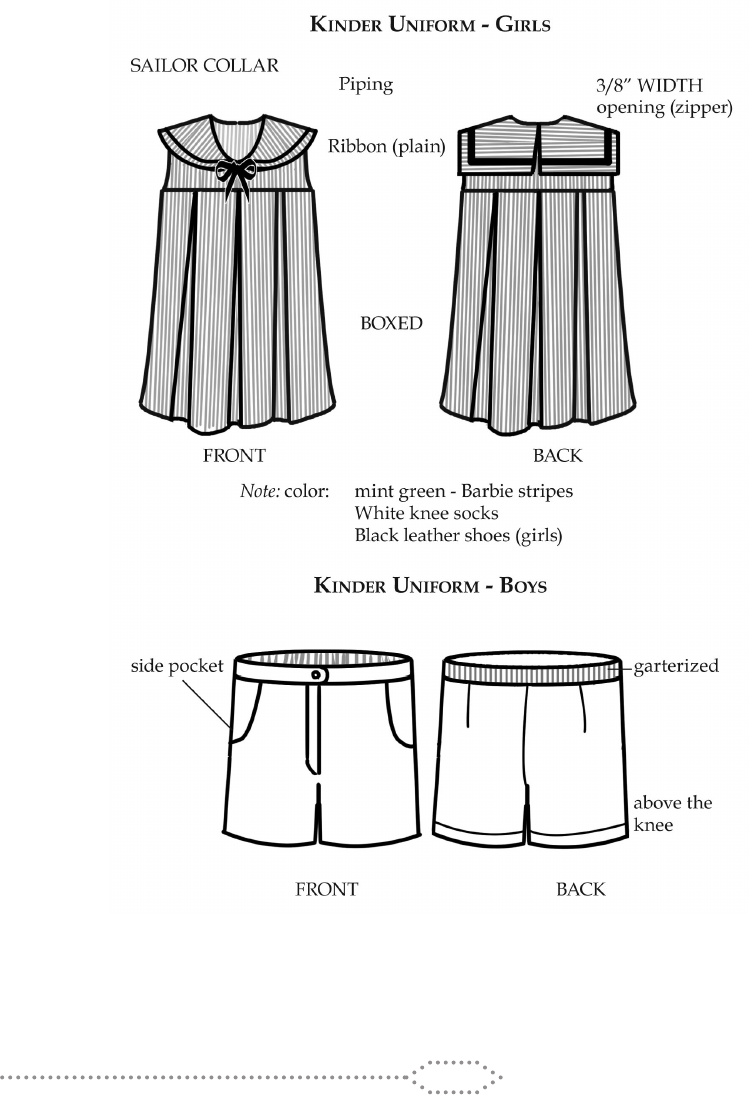
26
Note:
1. Short pants- moss green
2. Plain polo shirt with school patch
3. Black leather shoes with white socks
IV. SCHOOL UNIFORMS
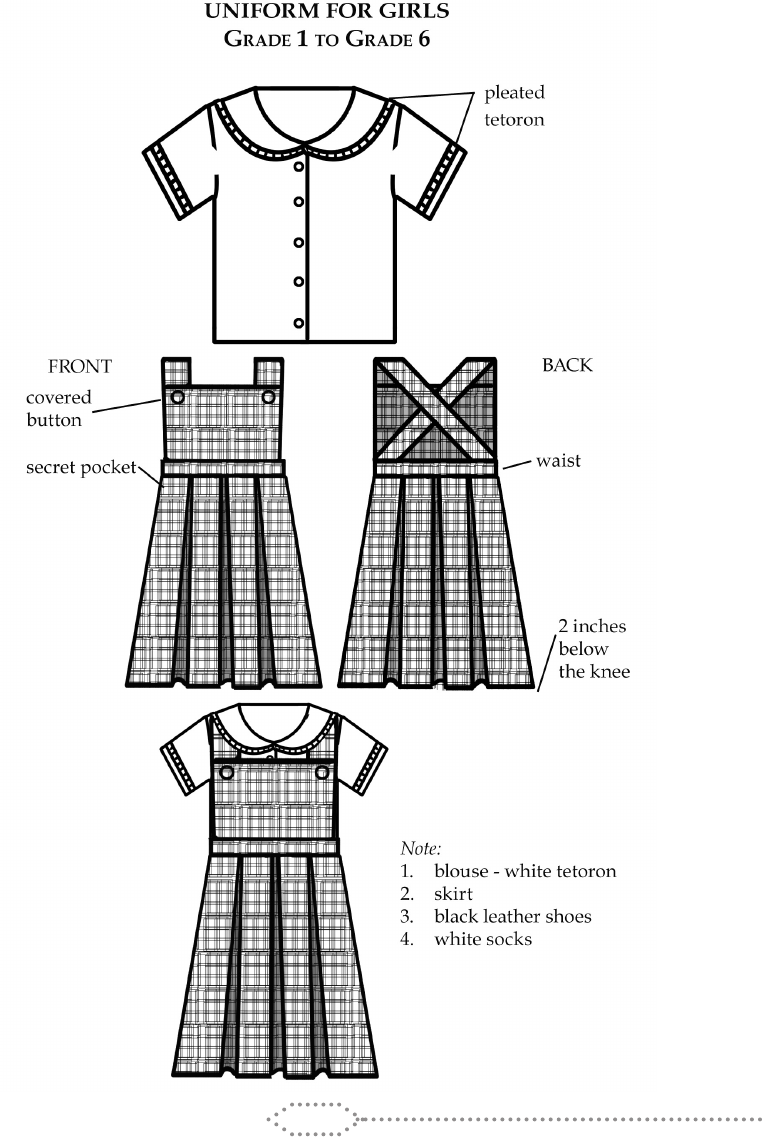
27
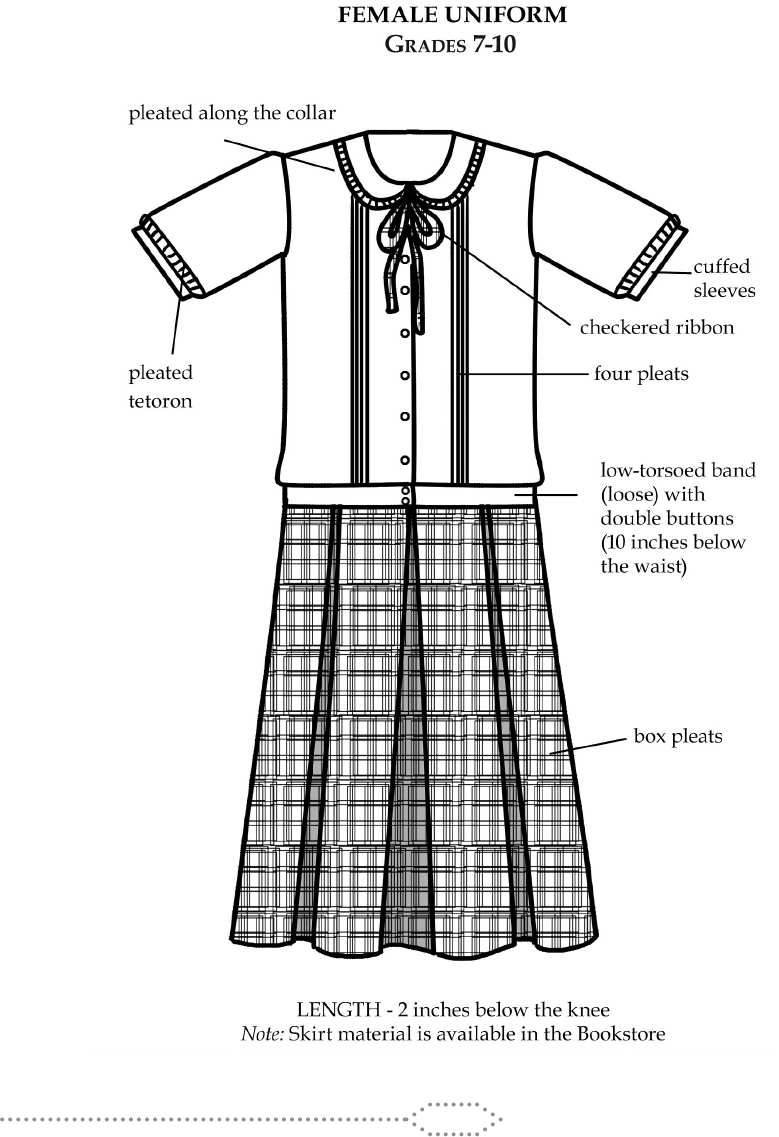
28
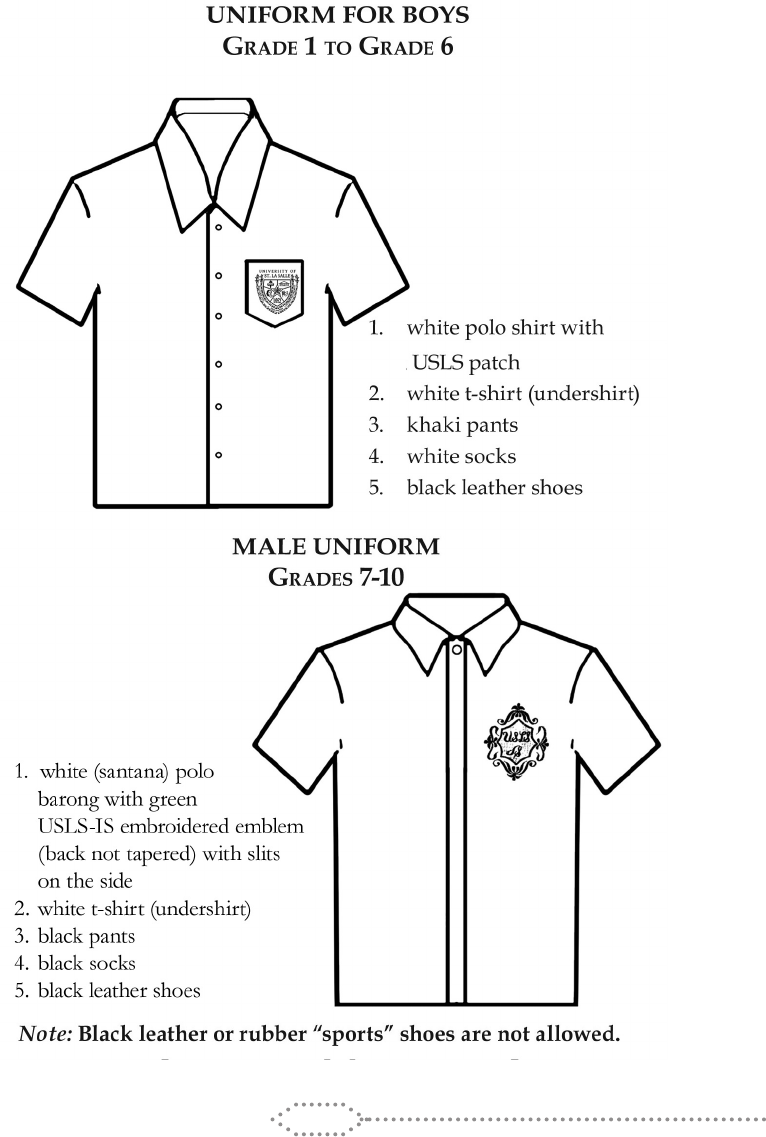
29

30
V. COMMUNICATION SYSTEMS
A. DAILY BULLETIN
The Daily Bulletin is a daily publication of USLS-IS and carries ofcial notices
and information on school matters. Students are held responsible for the
knowledge of its contents. Any announcement to be published the following day
should be submitted to the Vice Principal for Academics Ofce by 2:30 p.m.
B. THE IS REVIEW
It is a quarterly info-bulletin published to inform the IS community of
important achievements and announcements.
C. CIRCULARS / LETTER FOR PARENTS
1. Circulars/letters for parents are sent through the students. Students
are responsible for returning the reply slip signed by their parents/
guardians to the homeroom advisers/subject teachers. Failure to
submit the reply slip on the designed date will merit an appropriate
disciplinary sanction and may affect the student’s Homeroom grade.
2. Circular letters and other announcements may also be posted on the
Daily Bulletin or the IS Review.
3. In all cases, the parents and/or their children shall be bound by any
new rule, regulation and/or policy that may have been announced
through the circular on the date of its effectivity.
D. PUBLIC ADDRESS SYSTEM
It is available at the Junior High School Level Ofce and IS Main Ofce and
is used for ofcial notice on school matters and other special announcements.
E. BULLETIN BOARDS
1. Important announcements and notices are posted on various bulletin
boards.
2. Students are reminded that bulletin boards are for ofcial use only.
Therefore, tampering with notices is considered a serious offense.
3. Students may post notices or other materials only on designated areas
with the approval of the Level Vice Principal. Unauthorized notice and/
or materials may not be posted.
F. OFFICIAL SCHOOL PUBLICATIONS
1. GREEN BEACON and CROSSROADS
These are the ofcial school papers in English of the Grade School and
Junior High School, respectively. The papers are managed by the members
of the Editorial Staff and the moderators.

31
2. LUNTIANG TANGLAW and ANG LAYAG
These are the ofcial school papers in Filipino of the Grade School
and Junior High School, respectively. The papers are managed by the
members of the Editorial Staff and the moderators.
VI. PRINTOUTS/REPORT CARDS
Computer printouts of the grades are issued at the end of the First, Second, and Third
quarters. As an important parental obligation, parents/guardians are reminded to
keep track of the scheduled distribution of printouts to avoid any inconvenience in the
future.
The ofcial report card (SF9) is issued at the end of the school year.
VII. PARENT - TEACHER CONFERENCE
1. Parents are welcome to visit the school for a conference with the teachers
regarding the academic and/or disciplinary standing of their children/wards.
2. After distribution of grades printouts for the recently concluded quarter, a
timely conference with the teacher/s concerned may be arranged by the
parents/guardians, during the scheduled Parent-Teacher Conference (PTC)
week through the respective Ofce of Level Vice Principal.
3. Appointments are usually scheduled after classes in the afternoon when the
teachers are mostly available.
4. Those who have an appointment with the teachers in the Lower Grades or
have other transactions in the ofce have to log in and out with the Security
Guard at Glass Door # 3. A conrmation slip will be issued by the Lower
Grades Level Secretary to be given to the Guard as they go out of Glass
Door # 3.
VIII. PARENT ASSEMBLIES
Parent assemblies are held during the school year usually during the issuance of
printouts or appropriate occasions. Parents are encouraged to take this opportunity
to meet with their child’s teachers and discuss matters which might be of concern to
them. While these are not times for lengthy conferences, parents should feel free
to discuss a phase of their child’s progress and set another appointment for further
discussion should they feel this is necessary
IX. USE OF SCHOOL FACILITIES
A. USE OF SCHOOL FACILITIES
Use of school facilities such as classrooms, Covered Courts, PAASCU Room,
HELE/TLE Laboratories, Balay Kalinungan, AVR, etc. by students or groups is
allowed provided the activity is supervised by a teacher or a moderator.
For facilities needed for overnight use, persons responsible must secure a
form from the Vice Chancellor for Administration and forward the same to the
Ofces of the Principal and of the Level Vice Principal for approval. Use of the
facilities on Sundays and holidays must likewise be approved by both ofces.

32
B. USE OF TELEPHONE
Use of telephone is restricted to recess, lunch break and dismissal time.
Students are not allowed to use the phone during class time, unless extremely
necessary and with the approval of the Level Vice Principal/DFO.
For any emergency, telephones are available in the following ofces:
• Vice Principal for Academics 432-3769 or 432-1181 Loc. 158
• Lower Grades Level Vice Principal’s Ofce 433-5143 or 432-1181 Loc.
144
• Junior High School Level Vice Principal’s Ofce 432-0541 or 432-1181
Loc. 147
C. LOCKERS
Lockers are available for student’s use on a rst come-rst served basis. A
fee is charged for a year’s use. Payment is made at the Cashier. The ofcial
receipt together with a duplicate key is submitted to the ofce of the Level Vice
Principal for a locker assignment.
Locker keys must be surrendered at the end of the school year.
X. STUDENT SAFETY AND WELL-BEING
A. To ensure students’ safety and well-being, the school employs Security Guards
both in-house and from the agency. They are posted at the entrance and
exit gates on specied schedules. Parents, guardians and other guests are
required to present an ID in exchange of a Visitor’s Pass whenever they wish
to enter the school campus.
B. The presence of persons outside the school gates engaging in the selling of
questionable and unsanitary items poses a grave threat to the well-being
of the students. As such, students are discouraged to buy these items from
vendors.
C. For safety and order, playing is not held along the corridors. Students can
play in designated playing venues.
D. Rough and dangerous games such as roller blading, skateboarding,
slateboarding, skating, waveboarding and the like are not allowed inside the
campus.
XI. SUSPENSION OF CLASSES
A. DUE TO TYPHOONS, FLOODING, OTHER WEATHER DISTURBANCES AND
CALAMITIES
Pursuant to DepEd Order No. 43 S. 2012
Guidelines on the Implementation of Executive Order No. 66 (Prescribing
Rules on the Cancellation or Suspension of Classes and Work in Government
Ofces Due to Typhoons, Flooding, Other Disturbances, and Calamities)
1. Cancellation and suspension of classes are observed directly from

33
the weather bulletins of the Philippine Atmospheric Geophysical and
Astronomical Services Administration (PAGASA).
2. Classes in affected areas are automatically suspended based on
the PAGASA declared storm signals, while local government units
(LGUs) – not the DepEd – decide on and announce class suspensions
during calamities in the absence of a storm signal.
3. Classes in the affected areas shall automatically be cancelled or
suspended once the PAGASA raised the following storm signals:
1.) Signal No. 1, public and private pre-school and kindergarten
classes; 2.) Signal No. 2, public and private pre-school, kindergarten,
elementary and high school classes (including Senior High School); and
3.) Signal No. 3, classes in all levels.
4. Storm signal warnings declared by PAGASA at 10:00 PM, and 4:30
AM of the following day will reect the cancellation and suspension of
classes for the whole day in appropriate levels in the affected areas.
5. Storm signal warnings declared by PAGASA at 11:00 AM will
automatically cancel or suspend the same day’s afternoon classes in
the appropriate levels in the affected areas.
6. In the absence of storm signal warnings, LGU ofcials are expected to
announce not later than 4:30 AM for whole day cancellation or suspension
or not later than 11:00 AM for afternoon cancellation of suspension.
7. Furthermore, DepEd calls on parents to practice their discretion on
determining whether their children should go to school during typhoons,
oods and other calamities, even in the absence of cancellation or
suspension of classes announcement.
B. DUE TO TRANSPORTATION STRIKE
Due to certain constraints and for the safety of the students, parents are
encouraged to decide for their children to attend or not to attend classes
during transport strikes.
C. DUE TO DECLARED HOLIDAYS
Classes are automatically suspended in cases of declared national, local or
school holidays.
D. DUE TO EMERGENCIES
During times of emergencies, The Principal, in consultation with the
Administrative Council, makes the decision on the proper course of action.
XII. STUDENT’S INSURANCE
Student Insurance coverage is provided by Philippine British Assurance Company, Inc.
ACC
IDENTAL DEATH & DISABLEMENT/DISMEMBERMENT - Php 100,000.00
PERMANENT AND TOTAL DISABILITY - 100,000.00
UNPROVOKED MURDER AND ASSAUALT - 100,000.00

34
ACCIDENTAL MEDICAL REIMBURSEMENT - 20,000.00
ACCIDENTAL BURIAL BENEFIT - 10,000.00
BURIAL BENEFIT DUE TO NATURAL CAUSES - 7,500.00
DAILY HOSPITALIZATION BENEFIT DUE TO - 300.00/day
ACCIDENT (mas. of 31 days) - 300.00/day
NATURAL CAUSES (max. of 15 days) - 300.00/day
COMPREHENSIVE GENERAL LIABILITY (premises and - 1,500.00
Operations only) - 150,000.00 (CSL)
AMBULANCE ASSISTANCE - 1,500.00
FIRE CASH ASSISTANCE - 5,000.00
The foregoing coverage will provide protection to the insured person 24 hours a day,
in or out of school starting starting June 1, 2019.
Procedure for claiming insurance benet:
1. Go to the Main Clinic to accomplish forms. School physician and clinic staff will
provide assistance.
2. Present all medical receipts for reimbursement.
3. Submit all forms and requirements to the HRDS ofce through the clinic.
4. Wait for 1-2 weeks for claims to be processed.
XIII. EXCERPTS FROM THE MANUAL OF REGULATIONS FOR
PRIVATE SCHOOLS
DEPED ORDER NO. 70
“Students are prohibited from using pagers and cellular phones (especially those with
text messaging) during class hours.”
SPECIAL GUIDELINES ON THE USE OF GADGETS:
Electronic gadgets such as cellphones, discman, laptops, iPods, iPads, MP3 players,
portable sound systems and the like are not requirements of the school. The school
will not be held responsible for the loss of these gadgets. Cellular phones must be
kept away from sight and must be switched off from 7:30 AM until recess, dismissal
time (lunch break, afternoon dismissal) and cannot be used in any learning session/
school activity, unless allowed or prescribed by the teacher for classroom instruction
use. Any device not allowed on campus shall be conscated and deposited at
the Level Vice Principal’s Ofce. All conscated items are subject to the declared
consequences and will be returned to the parents at a specied time.
In emergency cases, the calls may be made in the Level Vice Principal’s Ofce
upon approval by respective authorities.
Use of Electronic Gadgets
In a year, violators are subject to the following consequences:

35
1st Offense - Conscation, memory exercise, and violation report to
parents/guardian. Item should be claimed after class at
the Upper Grades Ofce upon submission of the memory
exercise.
2nd Offense - Conscation, memory exercise, and B in deportment. Item
should be claimed by the parent/guardian after class at
the Upper Grades Ofce upon submission of the memory
exercise.
3rd Offense - Conscation, memory exercise, and B- in deportment. Item
will be deposited in the school vault for a week and should
be claimed by the parent/guardian at the Upper Grades
Ofce after one week.
4th Offense - Conscation, memory exercise, C in deportment, and DP
status. Item will be deposited in the school vault for a
month and should be claimed by the parent/guardian at
the Upper Grades Ofce after one month.
PROPERTY WAIVER CLAUSE
The school will not recognize any responsibility over any loss or damages
of property brought to school.
DEPED ORDER NO. 34 1980
“Any student, teacher, professor, ofcer or employee of a university, college or
school who impedes, obstructs, prevents or defeats the right and obligation of a
teacher or professor to teach his subject, or the right of a student to attend to his
classes, shall be subjected to disciplinary action without prejudice to the criminal
liability of the offender.”
PARAGRAPH 146, MANUAL OF REGULATIONS FOR PRIVATE SCHOOLS 7TH
EDITION.
“Expulsion: The penalty of expulsion is an extreme form of administrative sanction
which debars the students from all public and private schools. To be valid and
effective, the penalty of expulsion is usually considered proper punishment for
gross misconduct or dishonesty and/ or such offenses as hazing, carrying deadly
weapons, immorality, drunkenness, vandalism, hooliganism, assaulting a teacher
or any other school authority or his agent or student, instigating leading to
participating in concerted activities leading to a stoppage of classes, preventing
or threatening students or faculty members or school authorities from discharging
their duties, or from attending classes or entering the school premises, forging or
tampering school records or transferring forms or securing or using such forged
transfer credentials.”

36
PARAGRAPH 148, MANUAL OF REGULATIONS FOR PRIVATE SCHOOLS 7TH
EDITION.
“In view of the fact that the school administrators, more particularly the teachers,
exercise in relation to students authority in loco-parentis, they shall have the right,
in case of minor offenses committed in their presence, to impose appropriate
disciplinary measures in the interest of good order and discipline.”
PARAGRAPH 151, MANUAL OF REGULATIONS FOR PRIVATE SCHOOLS 7TH
EDITION
“A student who has incurred absences of more than 20% of the required total number
of class and laboratory periods in a given time should not be given credit. A school may
adopt its own attendance policies for students belonging to the upper half of the class.”
THE DANGEROUS DRUGS ACT OF 1972: REPUBLIC ACT NO. 6425, ARTICLE V.
SECTION 28: HEAD, SUPERVISORS AND TEACHERS OF SCHOOLS
“For the purpose of enforcing the provisions of Articles II and III of this Act, all
school heads, supervisors, and teachers shall be deemed to be persons in authority,
and, are such as hereby vested with the power to apprehend, arrest or cause the
apprehension or arrest of any persons in authority if they are in school or within its
immediate vicinity, or beyond such immediate if they are in attendance at any school
or class function in their ofcial capacity as school heads, supervisors or teachers.
Any teacher or school employee who discovers or nds that any person in
the school or within its immediate vicinity is violating any provision of Article II or
III of this Act shall have the duty to report the matter to the proper authorities.
Failure to report in either case shall, after due hearing, constitute sufcient cause for
disciplinary action”.
XIV. IMPLEMENTING RULES AND REGULATIONS
FOR RANDOM DRUG TESTING
WHEREAS, the Comprehensive Dangerous Drugs Act of 2002 (Rep. Act 9165)
under Article 3, Section 36(c), requires students of secondary and tertiary schools to
undergo random drug testing.
WHEREAS, the same Section provides that said random drug testing be
conducted pursuant to rules and regulations as contained in the School Student
Handbook and further, require notice to parents, so far as the random drug testing
is concerned;
NOW, THEREFORE, premises considered, these rules and regulations to be
made an integral part of the University of St. La Salle Integrated School High School
Student Handbook, are hereby promulgated, as follows:
1. Generation of Sampled Students – As discussed and agreed by the Principal
From Grades 8-10 will be subjected to Drug Testing Program to initially derive
a base line data for the IS in its effort to create a drug free High School
Campus.

37
Thereafter and in so far as subsequent drug tests are concerned, further
samples shall be generated through random sampling or unless justiable
cause or reason requires for it to be conducted otherwise.
2. Matching of Samples with Class Schedules and Classrooms – The students
(identied through School ID #s) to be tested for the day, the class schedule
and dates are to be determined randomly. The matching and scheduling will
be done by the Guidance Service Center, the ofce of the Discipline and
Formation Ofcer and the Level Vice Principal.
3. Notice of Waivers – Notices and waivers will be sent to all parents of Grades 8-10
containing all pertinent information on the program, through the level Vice Principal’s
ofce, retrieval of which will be done by the Homeroom Advisers for submission to
the Level Vice Principal.
4. Drug Testing Procedure – The procedure for drug testing shall be as follows:
4.1 On the date and time of the drug test, the matched students will be
called to the Guidance Service Center for brieng. No outward sign of
the conduct of the drug test shall be made by the person notifying the
subjects of the drug test.
4.2 The testing will be conducted at the High School Satellite Clinic or any
other suitable testing site where he or she will be required to produce
his or her urine sample to be tested for drug use. The DFO, LVP, School
Medical Representative (doctor or nurse), INSPA Representative and
SAC Representative will be allowed to stay within the vicinity of the
testing site.
4.3 The urine sample will be divided into two parts, the rst of which shall
go to the University of St. La Salle and the other to the Department
of Health (DOH) for safekeeping. The rst part will be tested by a
DOH-accredited drug-testing center, to determine whether the same is
positive, the same being considered as initial test.
4.4 Safeguards should be put in place to guarantee the integrity of the
drug test.
5. Kind of Drug Test – The drug test to be a test for methamphetamine and/or
any other narcotic or stimulants as may be determined by school authorities.
6. Final Positive Test – In order for the test to be considered a positive drug
test, both the initial and the conrmatory test should be positive, except as
provided for under paragraph 7 hereof.
7. Challenge – Any student subjected to drug test may challenge through his/her
parent/s or legal guardian an initial positive drug test result by ling a written
petition to the Committee on Random Drug Testing. Said petition must be
veried. Failure to le the petition within a period of fteen (15) days from the
date of notice of the initial positive drug test result shall be deemed waiver
of the right to challenge said drug test and the same shall be considered as
having been conrmed as a nal positive test. No challenge shall be allowed
from a negative drug test result, unless on proof of false or fraudulent drug

38
test. Said challenge in writing which may be brought by any person shall be
veried. If a drug test is challenged in this manner, the DOH shall conduct
a drug test on the sample it is holding for safekeeping and should this be
positive, this will constitute a nal positive drug test result.
False or Fraudulent Drug Test Result – Submission of false or fraudulent
drug test result shall be considered a positive drug test result. Any other
person conspiring with any person or aiding him or her in producing such
false or fraudulent drug test result will be penalized in accordance with
the law.
8. Condentiality – In the conduct of the random drug testing, all parties are
required to observe condentiality.
9. Students’ Rights – The rights of students as enriched in the Magna Carta for
Students and as established in the Student Handbook shall be fully protected
in the conduct of the random drug testing. Any violation of student’ rights shall
be dealt with accordingly.
Post-test Consequences of Positive Drug Test – Any person found to be positive
for drug test in accordance with paragraph 6 hereof shall be required to
submit to the post-test procedure, as follows:
• 1st Offense: Counseling – He or she shall be required to undergo counseling
with the proper school authority. A conference with the student and parent
concerned shall be conducted.
• Rehabilitation – It is determined from counseling and other tests that the
level of addiction is such that it should warrant further action; the person
found positive for drug test shall be required to undergo rehabilitation
in accordance with the law. The cost for rehabilitation shall be borne by
the parents.
• 2nd Offense: If for a 2nd drug test the student is still found positive,
he or she shall be suspended from attending classes for a period not
exceeding twenty percent (20%) of the prescribed class days for the
school year.
• 3rd Offense: If for a 3rd drug test, the student is still found positive, he/
she shall be dismissed from the University.
The provisions above will be considered only as far as the Random Drug
testing is concerned. All other offenses subject to disciplinary sanctions
as found in the student handbook still apply.
XV. EXCERPTS ON ANTI-BULLYING ACT OF 2012
AN ACT REQUIRING ALL ELEMENTARY AND SECONDARY SCHOOLS TO ADOPT
POLICIES TO PREVENT AND ADDRESS ACTS OF BULLYING IN THEIR INSTITUTIONS
Be it enacted by the Senate and House of Representatives of the Philippines in Congress
assembled:
Section 1. Short Title. This Act shall be known as the “Anti-Bullying Act of 2012”

39
Section 2. Acts of Bullying. – For purposes of this Act, “bullying” shall refer to any
severe or repeated use by one or more students of a written, verbal or electronic
expression, or a physical act or gesture, or any combination thereof, directed at
another student that has the effect of actually causing or placing the latter in
reasonable fear of physical or emotional harm or damage to his property; creating
a hostile environment at school for the other student; infringing on the rights of
the other student at school; or materially and substantially disrupting the education
process or the orderly operation of a school; such as, but not limited to, the following:
(a) Any unwanted physical contact between the bully and the victim like
punching, pushing, shoving, kicking, slapping, tickling, headlocks,
inicting school pranks, teasing, ghting and the use of available
objects as weapons;
(b) Any act that causes damage to a victim’s psyche and/or emotional
well-being;
(c ) Any slanderous statement or accusation that causes the victim undue
emotional distress like directing foul language or profanity at the
target, name-calling, tormenting and commenting negatively on victim’s
looks, clothes and body; and
(d) Cyber-bullying or any bullying done through the use of technology or
any electronic means.
“Now, therefore, the school highly discourages all students from creating and/or
maintaining an account in the social networks especially those that can not provide
an effective mechanism that would enable the recipient to trace the source of
communication, in the interest of holding the source accountable for any undesirable
effect/s caused by his/her irresponsible use of the social network.”
XVI. USLS-IS ANTI- BULLYING AND CHILD PROTECTION PROGRAM
This Anti – bullying and Child Protection Program will serve as guide to the University
of St. La Salle Integrated School in addressing concerns related to RA 10627 and the
Department of Education’s advocacy on child protection.
A. OBJECTIVES:
This program aims to:
1. identify composition of the anti – bullying / child protection policy
committee
2. increase the level of awareness among stakeholders regarding RA
10627
3. develop formation programs to avoid incidence of bullying
4. institute guidelines on how to handle bullying cases
B. DEFINITION OF TERMS
For purposes of clearer and common understanding of bullying, the following
denition of terms shall be used as stipulated in RA 10627:

40
“Bullying” refers to any severe, or repeated use by one or more students
of a written, verbal or electronic expression, or a physical act or gesture,
or any combination thereof, directed at another student that has the effect
of actually causing or placing the latter in reasonable fear of physical or
emotional harm or damage to his property; creating a hostile environment
at school for the other student; infringing on the rights of another student at
school; or materially and substantially disrupting the education process or the
orderly operation of a school; such as, but not limited to, the following:
1. Any unwanted physical contact between the bully and the victim like
punching, pushing, shoving, kicking, slapping, tickling, headlocks,
inicting school pranks, teasing, ghting and the use of available
objects as weapons;
2. Any act that causes damage to a victim’s psyche and/or emotional
well-being;
3. Any slanderous statement or accusation that causes the victim undue
emotional distress like directing foul language or profanity at the
target, name-calling, tormenting and commenting negatively on victim’s
looks, clothes and body;
4. “Cyber- bullying” or any bullying done through the use of technology
or any electronic means. The term shall also include any conduct
resulting to harassment, intimidation, or humiliation, through the use
of other forms of technology, such as, but not limited to texting, email,
instant messaging, chatting, internet, social media, online games, or
other platforms or formats as dened in DepED Order No. 40, s. 2012;
and
5. Any other form of bullying as may be provided in the school’s child
protection or anti-bullying policy, consistent with the Act and this IRR of
R A 10 62 7.
The term “bullying” shall also include:
1. “Social bullying” – refers to any deliberate, repetitive and
aggressive social behavior intended to hurt others or to belittle
another individual or group.
2. “Gender-based bullying” – refers to any act that humiliates or
excludes a person on the basis of perceived or actual sexual
orientation and gender identity (SOGI).
C. PROHIBITED ACTS
The following are acts which may warrant corresponding sanctions:
1. Bullying at the following:
a. school grounds;
b. property immediately adjacent to school grounds;

41
c. school-sponsored or school-related activities, functions or
programs whether on or off school grounds;
d. school bus stops;
e. school buses or other vehicles owned, leased or used by a school;
f. school buses or school services privately-owned but accredited by
the school.
2. Bullying through the use of technology or an electronic device or other
forms of media owned, leased or used by a school.
3. Bullying at a location, activity, function or program that is not school-
related and through the use of technology or an electronic device or
other forms of media that is not owned, leased or used by a school;
and
4. Retaliation against a person who reports bullying, who provides
information during an investigation of bullying, or who is a witness to
or has reliable information about bullying.
D. ANTI – BULLYING COMMITTEE
To ensure the smooth implementation of the program, the Anti – Bullying or
the Child Protection Policy Committee is formed. The committee will tackle
related issues and concerns and will be in – charge of formulating or drafting
different programs and activities to suppress and eventually eliminate
incidence of bullying in the Integrated School, monitors all cases of anti –
bullying and makes referrals to appropriate agencies and ofces as may be
required by the circumstance. The following are the designated members of
the Committee:
1. Principal – Chair
2. Level Vice Principals
3. Discipline and Formation Ofcers
4. Guidance Director
5. Senior Teacher ( 2 )
6. SAC Representative
7. INSPA Representative
E. ANTI – BULLYING CAMPAIGN
The success of the program progresses from a very good information
campaign to a more denite set of guidelines. To realize the desired goals
and objectives of the program, the following strategies will be used to ensure
that stakeholders are properly oriented with the provisions of RA 10627 and
the policy of the Integrated School related to this.
1. Orientation Phase
• The Ofce of the DFO together with the Ofce of the Level Vice

42
principal at the start of the school year provides time for students
to be oriented with the schol’s policies on discipline giving
emphasis on bullying.
• Faculty members and other school personnel are given the same
orientation during summer in – service training.
• The parents through the parent association , INSPA , is encouraged
to include anti – bullying talks to parents to help them recognize
signs whether their child is experiencing bullying as a victim or as
a bully.
2. On – going regular reminders through:
• the daily bulletin
• during Monday’s and Friday’s general assemblies
• homeroom classes
3. A week activity to highlight Anti – bullying to include the following :
• Launching of Anti – bullying Week
• Poster making contest
• Slogan writing
• Online Video presentation c/o shidokan
• Ribbon to show support to “ NO to Bullying” c/o SAC
F. FORMATION PROGRAMS
Certain Existing programs of the school support the goals and objectives of
the anti – bullying and the child protection policy and thereby also supported
and sustained. The following formation programs are believed to proactively
hinder bullying in school:
1. Formation sessions initiated by the Ofce of the DFO such as:
• Formation for athletes
• Talk on vices and its effects to Grade 7 and 8 students
• Summer camp program for students with discipline problem
2. Integration of topics in CLE or Values Education such as
• Respect for the dignity of others
• Lasallian attributes
3. Empowerment of student leaders as stewards of God’s creation through
good leadership and examples ( LOTS )
4. Spiritual formation program of the Campus Ministry
• Search – in
• Recollection
5. Counselling programs of the Guidance Services Center

43
6. Stick a “ No to Bullying Sticker “
7. I am my brother’s keeper
XVII. REMINDERS FOR PARENTS/GUARDIANS
A. GROWTH IN PERSONAL RESPONSIBILITY
Parents/guardians or their representatives are enjoined to promote and
develop personal responsibility in the students; hence, NO DELIVERIES OF
MATERIALS OR SUPPLIES (left at home or forgotten to bring by students) ARE
TO BE MADE DURING CLASS HOURS.
B. WAITING AREA
1. At dismissal time, parents/guardians passing through Gate #2 will wait
for their child/children at the following areas:
• Glass Door #1 – for Grades 1 and 2 AB students
• Glass Door #3 – for Grades 2 CDE and Grade 3 students
2. Grade 2 CDE will use Glass Door #1 during their early dismissal.
3. Glass Door #1 will be closed 30 minutes after dismissal.
4. Grades 4 to 6 students will be picked up at Gate 7 or 8 (Santuario
area).
C. SPECIAL REMINDERS
1. Parents guardians and helpers including non- IS personnel are not
allowed to loiter in the campus in the morning and at dismissal time.
They have to wait outside the Glass Door.
2. Parents/guardians are not allowed to eat their own lunch at the
canteen area.
3. Only those who have valid ID or Season’s Pass shall be allowed to
enter the Lower Grades Level area during lunch time.
4. A curfew at 6:00 pm has been imposed, thus, children must be fetched
by their parents/guardians/helpers on time. Curfew time may be
extended during Performance Tasks week.
5. Parents/Guardians of athletes staying in the venues during practices
after school must seek a Special Pass from the Varsity Sports Ofce.
D. DRESS CODE
In accordance with proper decorum, parents/guardians are expected to come
to school in appropriate attire at all times.

44
Part 3
ACADEMIC POLICIES AND PROCEDURES
I. ACADEMIC CURRICULUM
The University of St. La Salle-Integrated School is an accredited institution by the
Philippine Association of Accrediting Schools, Colleges and Universities (PAASCU)
and has attained level two status. As such, it is covered by DepEd Order No.32, s.
2006 which grants full curricular autonomy, an “authority to modify the curriculum
without DepEd approval provided that the minimum requirements and guidelines are
complied.”
The school has constantly evaluated and revised its curriculum to align with
the national standards, the De la Salle Philippines (DLSP) standards, and eventually
with the Philippine Catholic School Standards (PCSS). Embedded in the curriculum is
Understanding by Design framework which focuses on “teaching for understanding”
driven by the Lasallian Guiding Principles (LGPs) on Educational Experiences and the
core values of Lasallian Education: Faith, Zeal for Service, and Communion in Mission.
The curriculum is also designed to achieve the school’s vision-mission toward holistic
formation of students and academic excellence.
The instructional time is 50 minutes except in KINDER which is 40 minutes.
THE INTEGRATED SCHOOL K TO 10 CURRICULUM
KINDER
English
Reading/Writing
Math
Filipino
Supervised Play and Learn Program (SPLP) including Christian Living Education and
Music, Arts, Physical Education & Health
Grade 1 Number of Meetings
Mother Tongue 1 1x
Christian Living Education with Values Education 1 3x
English 1 4x
Reading 1 4x
Mathematics 1 5x
Science 1 2x
Filipino 1 4x
Araling Panlipunan 1 4x
Music, Arts, Physical Education & Health (MAPEH) 1 3x

45
Grade 2 Number of Meetings
Mother Tongue 2 1x
Christian Living Education with Values Education 2 3x
English 2 4x
Reading 2 4x
Mathematics 2 5x
Science 2 2x
Filipino 2 4x
Araling Panlipunan 2 4x
Music, Arts, Physical Education & Health (MAPEH) 2 3x
Co-Curricular Club 1x
Grade 3 Number of Meetings
Mother Tongue 3 1x
Christian Living Education with Values Education 3 3x
English 3 4x
Reading 3 4x
Mathematics 3 5x
Science 3 2x
Filipino 3 4x
Araling Panlipunan 3 4x
Music, Arts, Physical Education & Health (MAPEH) 3 3x
Co-Curricular Club 1x
Grade 4 Number of Meetings
Christian Living Education with Values Education 4 3x
English/Reading 4 6x
Mathematics 4 5x
Science 4 5x
Computer Education 4 2x
Filipino 4 5x
Araling Panlipunan 4 4x
Home Economics and Livelihood Education (HELE) 4 2x
Music, Arts, Physical Education & Health (MAPEH) 4 3x
Co-Curricular Club 1x
Grade 5 Number of Meetings
Christian Living Education with Values Education 5 3x
English/Reading 5 6x
Mathematics 5 5x
Science 5 5x
Computer Education 5 2x
Filipino 5 5x
Araling Panlipunan 5 4x
Home Economics and Livelihood Education (HELE) 5 2x
Music, Arts, Physical Education & Health (MAPEH) 5 3x

46
Co-Curricular Club 1x
Grade 6 Number of Meetings
Christian Living Education with Values Education 6 3x
English/Reading 6 6x
Mathematics 6 5x
Science 6 5x
Computer Education 6 2x
Filipino 6 5x
Araling Panlipunan 6 4x
Home Economics and Livelihood Education (HELE) 6 2x
Music, Arts, Physical Education & Health (MAPEH) 6 3x
Co-Curricular Club 1x
Grade 7 Number of Meetings
Christian Living Education and Values Education 7 3x
Science 7 6x
Filipino 7 5x
Araling Panlipunan 7 4x
Computer Education 7 2x
Music, Arts, P.E. and Health 7 3x
English 7 6x
Mathematics 7 6x
Career Pathways in Tech. and Livelihood Education (CP-TLE) 7 2x
Co-Curricular Club 1x
Grade 8 Number of Meetings
Christian Living Education and Values Education 8 3x
English 8 5x
Filipino 8 5x
Araling Panlipunan 8 4x
Science 8 5x
Mathematics 8 6x
Career Pathways in Tech. and Livelihood Education (CP-TLE) 8 2x
Computer Education 8 2x
Music, Arts, P.E. and Health 8 3x
Co-Curricular Club 1x
Grade 9 Number of Meetings
Christian Living Education and Values Education 9 3x
English 9 5x
Filipino 9 5x
Araling Panlipunan 9 4x
Science 9 5x
Mathematics 9 6x
Career Pathways in Tech. and Livelihood Education (CP-TLE) 9 2x
Elective 9 (Bookkeeping 1) 2x

47
Computer Education 9 2x
Music, Arts, Physical Education & Health (MAPEH) 9 3x
Grade 10 Number of Meetings
Christian Living Education and Values Education 10 3x
English 10 6x
Filipino 10 5x
Araling Panlipunan 10 4x
Science 10 6x
Mathematics 10 5x
Bookkeeping 2 2x
Music Arts and Physical Education 3x
Computer Education 10 2x
Citizenship Advancement Training 1x
Elective 10 2x
II. SPECIAL ACADEMIC PROGRAMS
A. FILIPINO SPECIAL PROGRAM
This is given to foreigners or balikbayans who need assistance in learning the
Filipino language.
B. ENRICHMENT PROGRAMS
1. Elective Course Program
Grade 10 students are placed in the elective courses based on the
results of their National Career Assessment Examination (NCAE) and
the Center for Educational Measurement (CEM) Proler Test given while
they were in Grade 9. Students’ interest in the course offerings is also
considered in the elective placement procedure. The level Guidance
Counselor conducts individual or group career counseling to assist
students in their choice of elective courses and eventually their career
options.
As enrichment programs, elective courses acquaint Grade 10
students with foundational knowledge on subjects aligned with the
Senior High School tracks and College courses.
2. Club Offerings
As part of the holistic development of the students, the school offers
various club offerings from Grade 2 to 6 in the Lower Grades and from
Grade 7 and 8 in the Upper Grades. Grade 10 students may join the
existing student organizations and attend to their activities outside of
their regular class schedules.
Clubs are categorized as Service Clubs, Sports Clubs, Interest
Clubs and Academic Clubs. Students may enlist in the club of their
choice at the beginning of the school year. The Ofce of the Level Vice
Principal facilitates the grouping of the students in the different clubs

48
with assigned teacher-moderators.
3. Academic Excellence Program
The program is offered to selected students who excel in the different
learning areas and identied and recommended by the teachers and
Department Chairs concerned. They attend special sessions under
their mentors who prepare them for various academic contests and
endeavors.
4. Internationalization Program
To ensure global awareness and competitiveness among the students,
the school provides opportunities for students to participate in
international eld trips and benchmarking activities. Such may be
internally-initiated or a response to external invitations which the
school deem t for the furtherance of their learning and development.
5. Special Events
The school likewise provides students the opportunity to actualize their
learning and enrich their leadership potentials and social development
through organizing, sponsoring, or hosting activities and special events
involving students and teachers from other schools.
III. SPECIAL ASSISTANCE PROGRAM
A. REMEDIAL PROGRAMS
Compulsory remedial programs are given to students who need assistance in
Math, Science, Reading, English, etc. as identied by the subject teachers and
recommended by the Department Chairpersons.
B. ACADEMIC BEHAVIORAL REPORT
This notice is issued to parents/guardians of students observed by the subject
teachers to be academically challenged during the rst four weeks of the
quarter. This notice is purely a reminder of the academic behavior of the
students in class and not a guarantee for failing or passing the subject. Upon
receipt of this notice, parents/guardians are requested to afx their signature
in the Reply Slip and send it back to the subject teacher concerned through the
student.
C. CONSULTATION TIME
Students with academic and personal problems or concerns are encouraged to
see their subject teachers after class for consultation purposes. Likewise, they
are encouraged to refer their concerns to the Department Chairs and Level
Vice Principal. Subject teachers may summon the students for a conference.
Specically, this period is utilized for:
• conducting remedial classes
• counseling of students
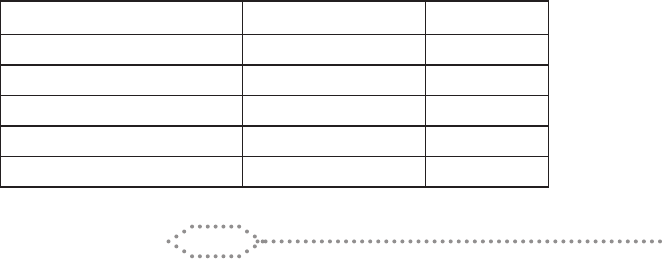
49
• verifying of scores and class standing
• taking make-up tests and long tests
• conducting review lessons
• conducting make-up classes
D. TUTORIAL
Any request for tutoring should be arranged with the Level Vice Principal for
approval according to certain guidelines.
Tutoring of students by non-IS Faculty is not allowed on campus.
IV. GENERAL ACADEMIC POLICIES
Academics is an integral part of the school’s effort to maintain and further
improve the quality of education that is offered to its clientele. Hence, these
policies are designed to provide directions to the students, who are involved
in the acquisition of knowledge, skills, understanding, application to real-life
situations and values relevant in the pursuit of excellence, as well as to their
parents or guardians.
A. GRADING SYSTEM
The point system is adopted as the grading system where all academic
activities in each subject are given total points. These points are earned by
the student in each quarter and whatever accumulated points a student has
earned are transmuted into percent and computed based on the weight of the
assessment components.
The school year is divided into four quarters. The quarterly grade
is based on summative assessments classied into written works (quizzes,
long tests, homework, seatwork, laboratory reports, research paper, etc.),
performance tasks, and quarterly examinations which are reective of the
academic performance of the student.
B. PASSING GRADE AND CUT-OFF SCORE
The highest grade that can be given to a student after transmutation of
performance shall be 100% and the lowest grade that can be given is 65%.
The passing grade is 75%. The passing cut-off score for any academic activity
or requirement is 60%.
C. DESCRIPTORS AND GRADING SCALE
Descriptor Grading Scale Remarks
Outstanding 90 – 100 Passed
Very Satisfactory 85 – 89 Passed
Satisfactory 80 – 84 Passed
Fairly Satisfactory 75 – 79 Passed
Did Not Meet Expectations Below 75 Failed

50
The summary of learner progress is shown quarterly to parents and
guardians in the report card with the grading scale and corresponding
descriptors. Remarks are given at the end of the grade level.
D. LETTER GRADES
1. The following student formation components merit letter grades:
• Homeroom
• Co-curricular Club (Grades 2 to 8 only)
• Citizenship Advancement Training (for Grade 10 only)
• Deportment (See Part 4 Discipline Policies)
2. Key to Appraisal
• A [95-100] B [80-84]
• A- [90-94] B- [75-79]
• B+ [85-89] C [74 and below]
E. HOMEROOM GRADE
This grade is given by the homeroom adviser based on the following criteria:
• Attendance in homeroom activities
• Participation in homeroom and school activities
• Prompt return of reply slips
• Cooperation in homeroom projects
F. CO-CURRICULAR CLUB GRADE
Grades 2 to 8 students receive quarterly co-curricular club grades determined
by the club moderators based on the following criteria:
1. Attendance in club activities
2. Performance in club activities
3. Participation/cooperation in club activities
4. Other criteria pertinent to the nature of the club
G. CITIZENSHIP ADVANCEMENT TRAINING (CAT) GRADE
Grade 10 students receive quarterly CAT grade based on their attendance,
discipline, participation and performance in the training program. However,
Grade 10 students with active membership in the Explorer Scouts and Girl
Scouts of the Philippines are exempted from the course. Respective moderators
will provide the grades at the end of each quarter.
H. FINAL GRADE COMPUTATION
The nal grade is the average of the four quarters. A nal grade of 74 is
rounded off to 75 whereas a nal grade below 74 will not be rounded off
and considered a failing grade.
I. COMMENT CODE
The report card contains a column for comment code that will help students
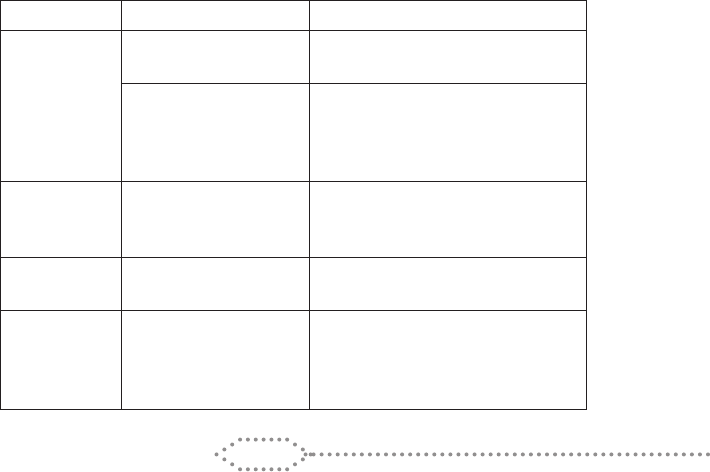
51
and parents understand the grade given by the teacher in a particular subject.
The comment codes are as follows:
A ______ Submits consistently quality school works
B ______ Participates actively in class discussions and activities
C ______ Needs to participate actively in class discussions and activities
D ______ Needs to submit quality product or present quality performance
task
E ______ Needs to submit/present required product/performance task
F ______ Needs to improve performance in summative assessment
G ______ Needs to perform better in quarterly assessment
H ______ Needs to be more attentive in class
I ______ Needs to come to school/class more regularly and punctually
X ______ Shows disruptive behavior in class most of the time
Y ______ Speaks English/Filipino consistently
Z ______ Shows excellent behavior in class
** Note: Letter appearing under Comments Code are different from those of
levels of prociency
V. STUDENT PROMOTION
The following guidelines for promoting a student to the next grade level must be
applied judiciously based on pertinent evidences.
A Final Grade of 75 or higher in all learning areas allows the student to be
promoted to the next grade level. The table below species the guidelines to follow
for learner promotion.
Requirements Decision
For Grades 1
to 3 Students
1. Final Grade of at least
75 in all subjects
Promoted to the next grade level
2. Did not meet
expectations in not more
than two subjects
Must pass remedial classes for subjects
with failing mark to be promoted to the
next grade level. Otherwise the student
is asked to withdraw from the school.
3. Did not meet
expectations in three or
more subjects
Withdrawal from the school
For Grades 4
to 10 Students
1. Final Grade of at least
75 in all learning areas
Promoted to the next level
For Grades 4
to 10 Students
2. Did Not Meet
Expectations in not more
than two subjects
Must pass remedial classes for subjects
with failing mark to be promoted to the
next grade level. Otherwise the learner
is asked to withdraw from the school.
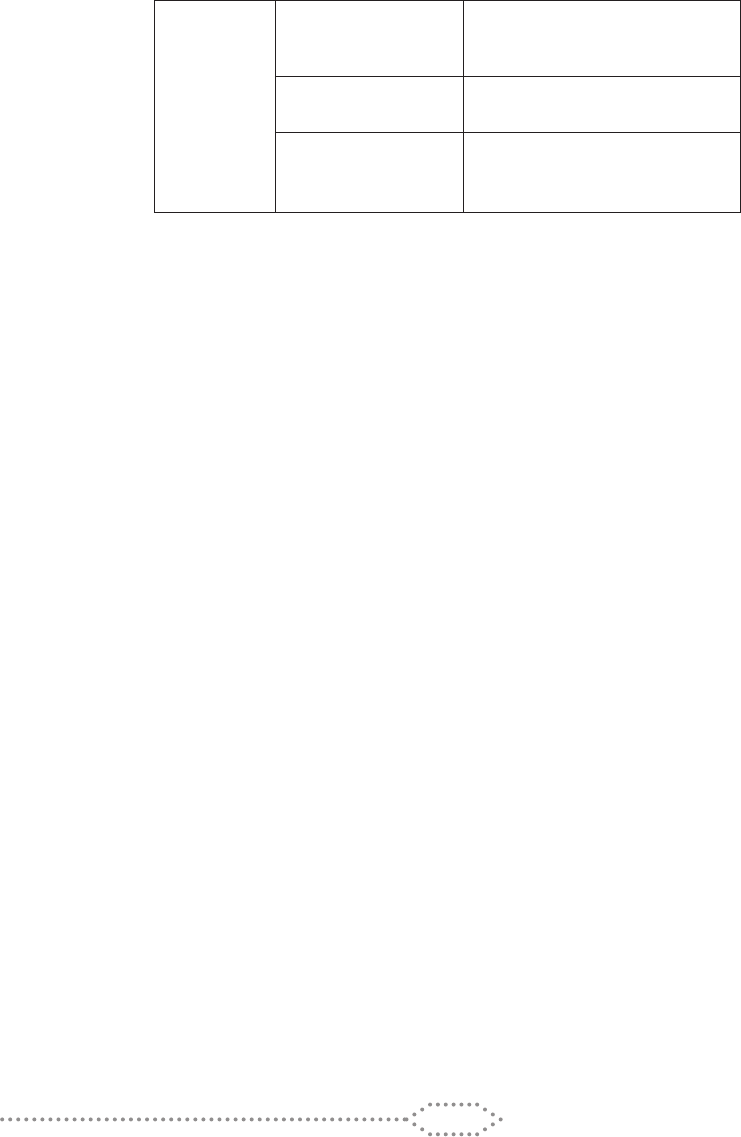
52
For Grades 4
to 10 Students
3. Did Not Meet
Expectations in three or
more subjects
Withdrawal from the school
4. Must pass all learning
areas in the Elementary
1. Earn the Elementary Certicate
2. Promoted to Junior High School
5. Must pass all subjects
in the Junior High School
1. Earn the Junior High School
Certicate
2. Promoted to Senior High School
VI. DEFERMENT OF GRADES
A. WHEN IS DEFERMENT OF QUARTERLY GRADES ALLOWED
1. When a student is medically advised to leave school temporarily for
about 35% or more of the total school days for the quarter provided
the student seeks clearance from the school physician.
2. When a new student enrolls in school after at least 35% of the total
school days of the rst quarter, due to the late school calendar where
he/she came from.
3. In special cases as deemed reasonable by the Principal or Vice
Principal for Academics.
B. GUIDELINES ON DEFERMENT OF GRADES/APPROVED ABSENCE
1. Deferment of grades may be given to a student once a year for every
school year.
2. The average of the succeeding two quarters is computed and becomes
the quarterly deferred grade of the student.
3. An approved absence is noted on the student’s attendance record but
is not counted against the allowable number of absences in the school.
VII. ACADEMIC PROBATION (AP Status)
Academic probation (AP) is a status imposed on students who have failed to meet the
minimum academic requirements of the school. Its purpose is to assist the students to
focus more on their academic performances.
A. WHO ARE PLACED ON ACADEMIC PROBATION?
1. A new student who falls below the requirements for admission set by
the Admissions Board.
2. Any student who incurs failure in 2 or more learning areas at the end
of the quarter. A notication letter to parents/guardians will be sent by
the Ofce of the Vice Principal for Academics. Parents/guardians are
expected to send back through their children the acknowledgement
slip at least three (3) days after receipt.
B. CONDITIONS OF ACADEMIC PROBATION

53
1. Any student on academic probation for 2 consecutive school years will
be readmitted on the third year provided that the academic probation
status is lifted during or after the second year of probation.
2. Any student on Academic Probation is not allowed to represent the school
in any NOPSSCEA, provincial, regional or national athletic competitions
during the quarter when the AP status is deemed effective.
3. A student placed on AP is advised to attend remedial programs,
consultations with subject teachers concerned, avail of tutorial services
and/or refrain from joining activities that may distract the student in
coping with the academic difculties.
C. LIFTING OF ACADEMIC PROBATION
Academic probation will be lifted at the end of every quarter if a student has
no failing mark in any subject.
VIII. EXAMINATION GUIDELINES
A. GUIDELINES FOR EXAMINATION
1. The school implements the NO PAYMENT, NO EXAM POLICY. (Please
see below VCA Memo No. 14 s. 2018-2019.)
2. Parents/guardians are advised to settle accountabilities at the Business
Ofce before the scheduled quarterly exams.
3. In order to ensure that the proper environment for concentration and
learning is maintained, students are expected to observe silence in the
exam room.
4. Students are not allowed to leave the room until the warning bell has
been rung.
5. Students are strongly encouraged to review their test papers before
submitting them to the proctor or homeroom adviser.
VCA Memo No. 14 s. 2018-2019
IMPLEMENTING GUIDELINES ON “NO PAYMENT, NO EXAM POLICY”
effective SY 2018-2019
For the INTEGRATED SCHOOL
1. The Business Ofce will release the statement of accounts to the Level
Vice Principals two (2) weeks before quarterly exams.
2. Three (3) days before exams, the Business Ofce will accept requests
for Promissory Notes (PN) requiring at least 50% of what is due
for the quarter. An exam permit is given after paying the amount
indicated in the PN.
3. Fines for non-payment of the balance as indicated in the Promissory
Note after a two-week grace period will be imposed as follows:
- 1st week after the deadline P100
- 2nd week after the deadline 200

54
- 3rd week after the deadline 300
- Beyond the 3rd week 100/week but not to exceed P500
4. Failure to pay the balance as indicated in the promissory note will
automatically disqualify the student’s parent or guardian to apply
for a succeeding promissory note.
5. On the First Day of exams, students without exam permit may be
allowed to take the exams for the day but will not be allowed to take
the exams for the succeeding days unless accounts have been settled
at the Business Ofce.
B. SPECIAL EXAMINATION GUIDELINES
When a student is absent during the exam days because of serious reason (i.e.
illness or unavoidable circumstances) the following should be followed:
1. Parents should notify the Level Vice Principal or Vice Principal for
Academics before the scheduled exams. If no communication is done
with the school, the student is not allowed to take a special exam.
2. SOP on absences should be followed by the student upon returning to school.
3. Students are required to pay P30.00 for every exam missed to defray
special exam preparation.
C. SPECIAL PROVISIONS ON CHEATING
Cheating is a form of academic dishonesty and it has no place in La Salle.
The students are expected to prepare for their lessons every day and do their
academic requirements and activities honestly.
To strengthen the Lasallian values formation program, the following
sanctions are imposed on students who violate this policy:
1. During a Summative Assessment
Cheating in any form during a summative assessment will forfeit the
student’s score for that assessment. The student should be reported to
the Level Vice Principal and/or DFO in writing. The next offense will put
the student under Disciplinary Probation (DP) with a C in Deportment.
2. During a Quarterly Assessment/Examination
Cheating in any form during the quarterly assessment or examination
will automatically fail the student in that particular subject for the
quarter because he/she forfeits all previous scores. The student should
be reported to the Level Vice Principal and/or DFO in writing. The
Deportment grade for that quarter will be C.
IX. POLICY ON HOMEWORK AND ASSIGNMENTS
Importance
Homework serves a very purposeful role in the learning process because
it establishes the link between school and the outside world. It establishes the

55
responsibility in students to “follow through.” That is, homework/or assignments help
them to accept responsibility for bringing work from school to home and then from
home to school.
Responsibilities of Parents and Guardians:
1. Participate in establishing a relationship between home and school;
2. Provide a good homework environment, including a quiet work space, proper
lighting, a specic time and necessary school supplies;
3. Help a child with homework assignments, such as Math or Spelling problems,
offer guidance with research and assist on project;
4. Provide help as needed, but also be sure that the work is completed by the
child, not the parent or sibling;
5. Check a child’s work to ensure the assignments are ready to be brought to
school;
6. Demonstrate an interest in the child’s work and offer praise and encouragement;
7. Be responsive to the child’s concerns or confusion about the assignments; and
8. Communicate with the subject teachers any related concerns.
Important: Appropriate homework and assignments may be required of all students
from Monday to Thursday. No homework is to be given during Fridays except for
subjects held twice or once a week.
X. AWARDS AND RECOGNITION
Pursuant to DepEd Order No. 36 s. 2016 entitled Policy Guidelines on Awards and
Recognition for the Kto12 Basic Education Program, the school confers awards and
recognition on deserving students for their outstanding performance and achievement
in academics, deportment, punctuality and attendance, leadership, literary, journalism,
cultural, sports, community service, religious and spiritual involvement, among other
aspects of student development. The process of selecting the awardees is based on
particular guidelines governing each type of award or recognition.
For academic honors, the awardees are veried by the Department
Chairpersons and the Vice Principal for Academics based on the grades submitted
by the subject teachers, including the Deportment, Homeroom, Club and CAT grades
generated by respective raters and processed by the Registrar’s Ofce through
its automated system. Non-academic awardees are determined on the basis of
the merits acquired i.e. garnering the top place/championship in a competition or
participation in a related event of high esteem as ofcially published in the IS Daily
Bulletin or IS Review or through a certication submitted for evaluation and upon
deliberation by the Awards Committee.
A. ACADEMIC AWARDS
The school recognizes meritorious achievements of students who excel
outstandingly in academics. The following academic awards are bestowed on
students who meet the criteria set: Academic Excellence Award, the General
Academic Excellence Award, and the Subject Excellence Award.

56
1. ACADEMIC EXCELLENCE AWARDS (AEA)
Certicates of academic excellence awards are granted quarterly to
Grades 1 to 10 students who meet the standards set for each category.
PRINCIPAL’S DISTINCTION
A student receives “PD” if he/ she has:
a. an average of 95% and above with no grade below 95% in all
subjects
b. a deportment grade of A
c. co-curricular and Homeroom grades of A
GOLD L
A student receives “Gold L” if he/she has:
a. an average of 90% and above with no grade below 90% in all
subjects
b. a deportment grade of A- and above
c. co-curricular and Homeroom grades of A- and above.
SILVER L
A student receives “Silver L” if he/she has:
a. an average of 88% and above with no grade lower than 88% in
all subjects
b. a deportment grade of B+ and above
c. co-curricular and Homeroom grades of B+ and above.
ACHIEVEMENT
A student receives an “Achievement” if he/she has:
a. an average of 85% and above, no grade below 85% in all
subjects
b. a deportment grade of not lower than B+
c. co-curricular and Homeroom grades of B+ and above.
To get academic honors in the nal, the student must not have any grade
lower than 85% or B+ in all learning areas including Homeroom, Co-
curricular Club and Deportment at any time during the school year.
AEA awardees for the rst three quarters are recognized during
the quarterly Honors Assembly for each grade level. However, due to
time constraints, certicates of awards for Fourth Quarter and Final
Honorees are distributed to students/parents during the issuance of
Report Cards at the end of the school year.
2. GENERAL ACADEMIC EXCELLENCE AWARD (GAEA)
a. The top two students in Grades 1 to 5 and Grades 7 to 9 with the
highest General Scholastic Average (GSA) receive Gold Medals
as General Academic Excellence Awardees during the annual
Lasallian Achievers Convocation (LAC). The awardees, however,

57
must have no grade lower than A- in Deportment; likewise, grades
in Homeroom and Co-curricular club (for Grades 2-8 only) must
not be lower than A- in any quarter.
b. Grade 6 and Grade 10 Academic Excellence awardees are
determined based on the average of the six (6) learning areas
(English, Math, Science, Araling Panlipunan, Filipino and Christian
Living Education) during the current year. The candidates should
have no grades lower than 85% in all subjects. Deportment
grade should be at least B+ and Homeroom grade must not be
lower than B+. CAT grade for Grade 10 should have a remark
of “Passed”. They receive Gold, Silver, and Bronze Medals
depending on their ranks during their respective culminating
rites.
3. SUBJECT EXCELLENCE AWARD (SEA)
This is awarded to students with the highest nal marks but not lower
than 90% in English, Science, Math, Social Studies, Filipino or Christian
Living Education irrespective of their grades or performances in other
subjects. Students who are enrolled in the Special Filipino Class are not
qualied for the award in Filipino.
Grade 6 and Grade 10 SEA awardees receive Gold Medal and
certicates during their respective culminating rites. Grades 7 to 9
awardees receive Certicates during the annual Lasallian Achievers
Convocation.
4. SPECIAL ACADEMIC CITATION
A Special Academic Citation certicate is awarded during the
culminating rites to Grade 6 and Grade 10 students who topped or
championed academic competitions (such as the Rotary Academic
Excellence Contest, MTAP, etc.) in the district, division, provincial, regional,
national or international levels. Grades 1-5 and Grades 7-9 awardees
are recognized during the annual Lasallian Achievers Convocation.
B. NON-ACADEMIC AWARDS GIVEN DURING RECOGNITION RITES
1. DEPORTMENT AWARDS
a. A certicate of recognition is given to any student at any quarter
for exhibiting excellence in behavior.
b. A student must have 2 Z comments in any two academic subjects,
must be cleared of any violation stated in Student Handbook,
no X in any other subjects, minimum grade of A- in Homeroom,
minimum grade of 85 in all subjects, and no recorded tardiness for
the quarter based on the record of the Discipline and Formation
Ofce during the quarter.
c. The awardee for the quarter receives a personalized Lasallian
Deportment Certicate (LDC) during the Honors Assembly.

58
d. At the end of the school year, any student awarded the LDC
for four (4) consecutive quarters is bestowed Excellence in
Deportment Award (EDA) provided the Z comment during the
year should include four different subjects.
Grade 6 and Grade 10 EDA awardees receive Certicates during
the Recognition Rites after the Thanksgiving Mass while Grades
1 to 5 and Grades 7 to 9 awardees are recognized during the
annual Lasallian Achievers Convocation.
e. List of candidates for the award is posted at the Faculty Room for
a review a week after the quarterly exam and then the nal list
will be submitted by the grade level moderators to the Committee
Chair on Deportment for nal deliberation together with the
committee members.
2. PERFECT AND PUNCTUAL ATTENDANCE AWARD (PPA AWARD)
Certicate of recognition is given to a student for achieving perfect
attendance throughout the school year with no record of tardiness in
any of the quarters.
Grade 6 and Grade 10 PPA awardees are recognized during their
respective culminating rites.
3. OUTSTANDING ATHLETES AWARDS
Certicates of recognition are given to Grade 6 and Grade 10
student-athletes who have faithfully and consistently played for their
teams or individual sports provided they have not been under any
disciplinary probation in any quarter during the school year.
Special Citation in Sports certicates are given to Grade 6 and
Grade 10 student athletes who were awarded runners-up in NOPSSCEA,
Provincial, Regional, National athletic meets and other invitational sports
competitions. However, candidates must not have been under Disciplinary
Probation in any quarter of the current school year.
Grades 1 to 5 and Grades 7 to 9 athletic awardees are
recognized during the Stingers Pep Rally or Stingers Recognition Rites.
4. OUTSTANDING ORGANIZATION /CLUB AWARDS
Grade 6 and Grade 10 students who have shown outstanding
performance and participation as members of their respective
organizations or clubs receive Certicates of Recognition as determined
by their moderators during the Recognition Rites.
Outstanding Grades 2 to 8 students receive Certicates of
Recognition during the culminating activity of the accredited student
clubs and organizations towards the end of the school year.
5. SPECIAL CITATIONS
Special Citation certicates are awarded during the annual Lasallian

59
Achievers Convocation to Grades 1 to 5 and Grades 7 to 9 students
who, during the current school year, have represented the school and
topped journalism and literary-cultural competitions in the district,
division, NOPSSCEA, provincial, regional, national or international
levels such as but not limited to:
1. NOPSSCEA Literary-Musical Competitions
2. DSPC, RSPC, NSPC.
C. AWARDS EXCLUSIVELY GRANTED DURING CULMINATING RITES
1. AWARDS OF DISTINCTION
The following prestigious awards are granted only to Grade 10
students during their Completion Rites.
a. ST. LA SALLE AWARD
This award is given to a Grade 10 student who, during his/her junior
high school education has exemplied the true ideals of a well-
rounded Christian youth in the spirit of St. John Baptist de la Salle.
Criteria:
• Must have actively initiated curricular and co-curricular
activities
• Must have active involvement in any civic action program
• Must have a consistent high satisfactory grade (90 and
above) in Christian Living Education and Deportment
throughout his/her junior high school
• Must be an Alma Mater Awardee
b. ST. BR. BENILDE AWARD
This award is given to a Grade 10 student who has distinguished
himself/herself in the spirit of St. Benilde’s example of
leadership.
Criteria:
• Must have a position in any school accredited organizations
during his/her Grade 9 or Grade 10 level
• Must have exhibited humble and effective leadership
within the organization
• Has shown enthusiasm and dedication in performing his/
her duties within the organization
• Must have a consistent high satisfactory grade (90 and
above) in Christian Living Education and Deportment
throughout his/her junior high school
c. ST. BR. MIGUEL AWARD
St. Br. Miguel was a distinguished scholar and educator, an

60
eminent academician and exemplar who was also noted for his
kindness and affability.
This award is given to a Grade 10 student who most closely
approximates the life and spirit of this distinguished La Salle Brother.
Criteria:
• Must be in the top 3 ranks in the nal grading based on
Grade 9 and Grade 10 academic performance
• Must have exhibited mild, gracious and social demeanor
• Must have a consistent high satisfactory grade (90 and
above) in Christian Living Education and Deportment
throughout his/her junior high school
d. ST. BR. SOLOMON AWARD
This award is given to a Grade 10 student who develops his/
her talents during the current year in the service of the school
community.
Criteria:
• Must have exhibited a signicant achievement in academic
or non-academic activities during his/her Grade 10 level
• Has contributed to the positive image of the school through
the said achievement
• Has shown the zeal to overcome the challenge against
himself/herself, thereby gaining the respect and admiration
of the school community
• Must have a consistent high satisfactory grade (90 and
above) in Christian Living Education and Deportment
throughout his/her junior high school
e. BR. MUTIEN-MARIE AWARD
He dedicated himself for more than fty years to the education
of children in the Brother’s boarding school at Malonne, Belgium.
Br. Mutien-Marie did very ordinary things extraordinarily well.
The faith and zeal with which he served his students are worthy of
emulation.
Criteria:
• An active volunteer in the outreach activities of the school
during his entire junior high school
• Must have shown the extraordinary willingness to serve the
school in its social mission
• Must have a consistent high satisfactory grade (90 and
above) in Christian Living Education and Deportment
throughout his/her junior high school

61
f. BLESSED BR. SCUBILLION AWARD
He was sent on a missionary to the island of Reunion in the Indian
Ocean in 1833. There he became known for his work as a catechist
who promoted the cultural, moral and religious development of
the slaves.
Criteria:
• An active volunteer in the spiritual and religious activities of
the school during his entire junior high school
• Must have shown the extraordinary willingness to serve the
school in its spiritual and religious mission
• Must have a consistent high satisfactory grade (90 and
above) in Christian Living Education and Deportment
throughout his/her junior high school
g. BR. FRANCIS CODY, FSC HONORS SOCIETY AWARD
This award is given to the top ve Grade 10 students who
are ranked based on their entire junior high school academic
performance provided they have no grade lower than 82% (at
least until SY 2022-2023) in any subject and no grade lower than
B+ in Deportment in any of the quarters within four years. They
must have also attended complete junior high school in USLS-IS.
They shall receive a plaque of distinction and their names shall be
incorporated in the Honors Society as permanent members.
2. ALMA MATER AWARDS
Certicates of recognition are granted to Grade 10 students who have
spent and completed their entire elementary and junior high school
in the Integrated School. Those who have come from other La Salle
schools may apply for the award. Students who come from La Salle
supervised schools are not qualied for this award.
3. ATHLETIC AWARDS
a. Student athletes who have distinguished themselves as champions
in NOPSSCEA, Provincial, Regional, National athletic meets and
other invitational sports competitions such as Basketball, Volleyball,
Football, Swimming, Taekwondo, Athletics, Badminton, Lawn
Tennis, Table Tennis, Chess and Archery receive Gold Medals as
Athletic Awardees. However, candidates must not have been under
Disciplinary Probation in any quarter of the current school year.
b. In recognition of the outstanding performance of any Grade 10
student who has distinguished himself/herself in at least two (2)
sports in the NOPSSCEA, Provincial Meet, Regional Meet or other
national competitions, or performed outstandingly in swimming,
the Athlete of the Year Gold Medal Award is granted, provided

62
the candidate must have not been under Disciplinary Probation in
any quarter of the current school year.
4. LITERARY AND CULTURAL AWARDS
Gold Medals are given to Grade 6 and Grade 10 students who
have championed in any of the following events or competitions in the
NOPSSCEA, provincial, regional, national or international levels:
Theater Arts Visual Arts Dance Art
Music Declamation Photography
Folkdance Drumbeating Dance Sport
PopDance/HipHopDance Rhetoric/Public Speaking
5. SAC AWARD
Certicate of recognition is given to deserving Grade 6 and Grade
10 students who are members of the Student Affairs Council (SAC),
the governing body of all students’ organizations, for their exemplary
leadership and effective implementation of all student activities.
6. PUBLICATION AWARDS
Certicates of recognition are granted to Grade 6 and Grade 10
students who have:
a. been active members of the school paper for at least one (1) year
b. attended seminars/lectures/meetings regularly conducted by the
organization
c. shown commitment and deep involvement in the organization
d. been efcient and effective in handling assigned duties/
responsibilities
7. JOURNALISM AWARDS
Gold medal is awarded to a Grade 6 or Grade 10 student recognized
as champion in the division schools press conference (DSPC) or regional
schools press conference (RSPC), and a gold medal with special citation
for champions/placers/nalists/qualiers in the national schools press
conference (NSPC) within the school year.
8. ENGLISH PROFICIENCY AWARD
The English Prociency certicate is awarded to a Grade 10 student who
has effectively used the English language both in oral and written forms.
The recipients must have:
a. No grade below 92 in English in all quarters of the current year.
b. At least one (1) Y comment in any of the quarters of the current year.
9. CAT AWARDS
Qualied cadet/cadette ofcers of the Citizenship Advancement
Training (CAT) program receive this Certicate of Recognition for

63
their exemplary leadership and performance during the school year.
The awardees are determined by the CAT teacher-facilitator based
on certain criteria set for the awards.
10. SPECIAL CITATIONS
Special Citation certicates are given to outstanding Grade 6 and
10 students who brought honors to the school by their exemplary
performance in other distinctive events of local, regional, national or
international level OR in special sports such as Shooting, Bowling, Billiards,
Golf, Rock Climbing, Skim Boarding, Skateboarding, Gymnastics, etc.
11. ORGANIZATION AWARDS
Certicates of Recognition are given to MOST outstanding student
organization members who have contributed signicantly to the
realization of the objectives of the clubs/organizations of which they
are members, provided, their Deportment grade is at least B+ in any
quarter.
The following criteria are used to determine the awardees:
a. Responsibility
The awardee:
- directs all activities to the organization that he/she is a
member of.
- is generous in devoting time, presence, work and talent to the
organization.
- keeps his/her priorities in order and is able to meet the
obligation.
- is efcient and effective in handling his/her duties and
assignments.
- keeps communications open with members of the organization,
the SAC, the faculty, the parents and the administration.
- passes all his/her subjects at the end of the year.
b. Leadership
The awardee:
- is a positive inuence to the organization.
- is responsive to the needs of the organization.
- listens to and allows others to freely express and contribute
their ideas and suggestions.
c. Cooperation
The awardee:
- shares ideas with others, accepts feedback positively and
gives full support to decisions agreed upon.
- positively accepts decisions made by those to whom he/she
is accountable.

64
IX. PROCEDURE IN DETERMINING AWARDEES
The School Principal convenes an Awards Committee composed of appointed
members according to the nature of the awards for deliberation. In determining
the awardees, the committee takes into consideration all aspects of the candidates
who are nominated by the students, faculty, grade level counselors, coaches and
moderators in accordance with the existing criteria. The decision of the Awards
Committee is nal.
To facilitate the selection process, the following provisions of DepEd Order No.
36 series 2016 titled “Policy Guidelines on Awards and Recognition for the Kto12
Basic Education Program” are adopted:
The Awards Committee will:
1. establish the timelines in accepting nominations and in determining
establish the timelines in accepting nominations and in determining
qualiers for specic awards consistent with the guidelines.
2. verify the authenticity and accuracy of documents submitted.
3. deliberate on the qualications of the candidates for the awards
based on the set criteria and documents submitted.
4. recommend to the Principal the result of evaluation for approval.
5. communicate to the school community, parents and other stakeholders
involved the results of the evaluation.
6. announce/post the nal list of awardees
7. recommend to the Principal the resolution on any related issue that
may arise from the results of the awards.
Note:
1. The report on the results of the Awards Committee deliberation shall
be signed by all the members of the committee and certied by the
Principal.
2. The Awards Committee together with the Principal shall determine roles
and assign tasks to the awardees (e.g. Response from the awardees,
introduction of the guest speaker, etc.) for the annual Lasallian
Achievers Convocation.
3. Furthermore, the committee chooses Grade 6 and 10 students who
meet the criteria set by the committee to deliver the Thank You
speech during the respective Recognition Rites for Grade 6 and
Grade 10 and the Batch Message during the Completion Rites for
Grade 10.
4. Cases of protests shall be led by the candidate with his/her parent
or guardian to the Principal within three (3) working days from the
announcement and shall be decided on by the Principal, considering
the recommendations of the Awards Committee within three (3) working
days from lling.
5. The school reserves the right to determine the awardees with respect to
the prescribed criteria and procedure for selection.

65
Part 4
DISCIPLINE POLICIES
RATIONALE
The University of St. La Salle Integrated School offers education that is viewed from
a holistic perspective. The development of values and attitudes which encourages mature
and responsible behavior is viewed as an integral part of the education of the youth.
The sole purpose of the rules set and enforced by the school is to further the process of
developing a Christian and rened Lasallian. The students are encouraged to practice
self-control and discipline. However, since proper guidance, direction and correction are
necessary, the following policies will be carried out to maintain discipline and order not
only in school but in all areas of life.
PERFORMANCE EXPECTATIONS OF THE GOVERNMENT
The DepEd states that “Every private school is required to maintain school discipline
at a level consistent with accomplishment of good school work” and that “a private school
is entitled at any time to drop from school a student who is considered undesirable.” The
DepEd also provides the principal and teachers with a Special Parental Authority.
I. DISCIPLINE CASES
In disciplinary concerns that do not warrant dismissal, the Discipline and Formation
Ofcer (DFO) will handle discipline matters in coordination with the Level Vice
Principal. Otherwise, the matter will be referred to the Principal.
II. THE DISCIPLINE BOARD
The Discipline Board is a fact-nding body that may be convened by the Principal
to hear charge(s) on student(s) of any possible offense that may warrant dismissal
or expulsion. It shall be composed of ve (5) members appointed by the Principal. It
submits its ndings and recommendation to the Principal who makes the nal decision.
III. COMPUTATION OF DEPORTMENT GRADE
The deportment grade is computed by the Homeroom Adviser based on the number
of x’s and z’s found in the subject teachers’ comments code. X refers to disruptive
behavior, code Z refers to excellent behavior. However, the DFO’s deportment grade
will supersede the Homeroom Adviser’s if the former’s grade is lower. The DFO’s
grade is based on other violations committed by the student.
The nal deportment grade is based on the following:
A Outstanding (2 Z’s or more, no X’s) (95-100)
A- Highly Satisfactory (1’Z, no X’s) (90-94)
B+ Satisfactory (no Z’s, no X’s) (85-89)
B Fair (no Z’s, 1 X) (80-84)

66
B- Unsatisfactory (no Z’s, 2 X’s) (75-79)
C Subject to Disciplinary Action (no Z’s, 3 X’s) (74 and below)
IV. DISRUPTIVE BEHAVIOR
This is a behavior manifested or displayed by the student that interrupts and disturbs
the smooth ow of the teaching-learning process in the classroom. The behavior
is documented through the Student Class Deportment Report (SCDR) which will be
issued to the parent/guardian upon submission of the Student Deportment Report
(SDR) by the subject teacher.
The Code X is given to a student who fails to show consistent improved
behavior after the Student’s Class Deportment Report has been sent to his/her
parents/guardian. The following are classied as Disruptive Behaviors:
1. All forms of deance
2. Bringing and playing cards and toys during class
3. Boisterous laughter
4. Borrowing of books and other materials (especially from another room) during
class hours without asking permission
5. Coming in late during exchange of periods
6. Continuous talking, speaking indecent/vulgar words, making unnecessary or
irritating sounds in spite of a warning
7. Eating during class hours.
8. Uncontrolled verbal arguments inside the classroom during class hours
9. Habitually asking for pieces of paper/habitually borrowing of ballpens
10 Reading comics, pocketbooks, magazines and using materials and gadgets
not related to the subject during class hours
11. Transferring of seat during class without permission from the subject teacher
12. Unbecoming or indecent behavioral manifestation of boy-girl relationship
during class hours
13. Any offense analogous to the above.
V. DEFINITION OF CONSEQUENCES
For violations of school rules and regulations the following shall be imposed:
A. Warning
This is a written notication to both the student and parents/ guardians to
inform and caution the student on the consequences of the conduct.
B. Memory Exercise
A written activity given to students in order to remind him/her about a certain
school policy.
C. Work Detention
Work Detention is given for a matter which is considered by the DFO to be
serious either due to one isolated act or to consistent negative attitude or

67
behavior e.g. habitual misbehavior or disregard of school policy.
D. Suspension
Suspension from classes forbids attendance in regular classes but demands
the presence of the student in school to perform the task assigned by the DFO.
E. Dismissal
This is a nal and irrevocable withdrawal from school. The Principal, after
consultation with the Discipline Board, may dismiss a student. Dismissal
is incurred by misconduct of a very serious nature calling for immediate
withdrawal. However, DP/ SDP students who warrant dismissal do not require
the convening of the Discipline Board.
F. Expulsion
Expulsion is a very serious punishment recommended only by the Principal with
the approval of the Department of Education. A student who has been expelled
from school is forbidden to enroll in any other school.
VI. DISCIPLINARY PROBATION
This is a restraining measure on the student who has been guilty of a consistent
misbehavior or a single grave breach conduct. Its sole purpose is to help the student
improve his/her future conduct.
A. Who incurs Disciplinary Probation (DP)
1. A student who receives a grade of C in deportment for the quarterly
grade
2. An incoming student recommended to be placed on DP by the Admissions
Board
3. A student who commits an offense which would warrant that he/she be
placed on DP
B. Conditions for Disciplinary Probation
1. A student on DP who receives a failing grade in deportment for the
succeeding quarter is required to see the Discipline Ofcer with his/
her parent.
2. A student placed on DP status during the last two quarters or during
the 4th quarter only of the school year and with a nal deportment
grade of B- or below is required to attend the Summer Camp Program
for him/her to lift the status. Graduating students are to render
community service before and after graduation rites. Credentials will
not be released unless the student has complied with the number of
required hours.
3rd and 4th Quarter DP – 40 hours
4th Quarter DP – 20 hours
3. A student on DP may be allowed to participate in any provincial,

68
regional, and national eldtrip as soon as the status had been lifted
unless otherwise stated by the guidelines of the trip/activity.
4. Varsity athletes under DP/SDP status are not allowed to participate in
any ofcial/ invitational tournaments.
5. A student on DP status is required to render community work, as
assigned by the DFO, a week after the distribution of printouts.
C. Lifting of Disciplinary Probation
Disciplinary Probation may be lifted after one quarter if the student gets a
grade of B+ or above in deportment for the quarter. However, if a student
receives a grade of B or lower during the probationary period, his/her
probation will continue through the subsequent quarter of the same school year.
Grade 7 incoming students (including USLS-IS Grade 6) placed on
the status by the Admissions Board is required to lift his/her status during the
current school year, otherwise, he/she will be required to comply with the 80-
hour work during the Summer Camp.
VII. STRICT DISCIPLINARY PROBATION
A. Who incurs Strict Disciplinary Probation (SDP)
1. A student on DP who repeatedly violates school rules and regulations
and/or a student placed on DP for 2 consecutive quarters and still gets
a C in deportment for the succeeding quarter
2. A student who is guilty of a single grave offense in any school activity or
function on or off campus and/or in a public place where such offense
is a potential or a real danger to the reputation of the student, his/her
family, and the University of St. La Salle Integrated School (Refer to
Degree of Violation and their consequences)
3. A student on DP who commits a serious offense and receives a failing
grade of C in deportment at any quarter
4. A student who gets a C in deportment for 3 consecutive quarters
B. Conditions for Strict Disciplinary Probation (SDP)
1. If the student receives a failing grade in any quarter or commits a
Category Three, Category Four and Category Five offense as stated
in the student handbook, he/she is recommended for withdrawal at
anytime during the school year.
2. Any student on SDP cannot represent the school in any outside activity
or any school-initiated activity.
3. Varsity athletes on SDP are not allowed to participate in ofcial/
invitational tournaments (NOPSSCEA, Provincial and Regional Meet,
National Tournaments) during the school year.
4. A student on SDP is required to render community work for one
Saturday, a week after the distribution of printouts.

69
C. Lifting of Strict Disciplinary Probation
Strict Disciplinary Probation may be lifted after one quarter if the student
obtains a deportment grade of B+ or above. Once lifted, the student is
placed on DP status.
D. Summer Camp Program
1. Summer Camp Program is an 80, 60, 40 or 20-hour work in school at
the end of the school year required of a student who meets any of the
conditions below:
a. a student who failed in deportment (nal grade of C) at the end
of the school year
b. a student who is placed on DP status for the entire school year
c. a student who is placed on SDP status at any quarter
d. a student who is placed on DP status during the 3rd and 4th
quarters (No DP status from the 1st to 2nd Quarters) and with a
nal deportment grade of B-
e. a student who is placed on DP status during the 4th quarter
(No DP status from the 1st to 3rd Quarters) and with a nal
deportment grade of B-
2. Summer Camp attendance enables a student to lift his/ her DP/SDP
status and possibly be readmitted for the next school year. After
attendance of the required number of hours of Summer Camp Program,
a student with DP/SDP status at the end of the following year will be
evaluated for his/her re-admission or non-admission for the next school
year.
3. A student who is placed under SDP status but has manifested behavioral
improvement as shown by a clean deportment status at the end of the
school year will be subjected to re-evaluation by the DFO to decide on
the number of hours or nature of participation in the summer camp.
4. Students, foreseeing possible conicts that might cause him/her not
to attend the summer Camp Program, should communicate to the
school through his/her parents/recognized guardians before the
program begins. The student should support his/her claims with valid
documents.
The school may refuse the involvement of any student who would
fail to follow this procedure.
VIII. DEGREES OF VIOLATIONS AND THEIR CONSEQUENCES
A. LOWER GRADES
The following are offenses according to gravity with corresponding penalties:
Violations and Consequences are accumulated from 1st to 4th quarters.

70
CATEGORY ONE
Consequences
1st Offense - verbal, written warning to students
2nd Offense - written warning to parents
3rd Offense - conference with parents, B- in deportment
4th Offense - conference with parents, 1- day suspension, C in deportment,
DP status
5th Offense - conference with parents, 2- day suspension, C in deportment,
DP status
6th Offense - conference with parents, 3- day suspension, C in deportment,
SDP status
Violations
a) Incomplete uniform
b) Wearing of earrings for the boys and multiple earrings for girls, use of
colored lenses and the use of “punky” accessories on campus
c) Applying of colored hair dye, nail polish, make-up, lipstick on campus
d) Buying food from any vendor or eatery outside the campus during
recess
e) Disregard of submission on due dates of all ofcial communications
f) Disruptive behavior during related school activities
g) Failure to present a letter of excuse upon return from absence
h) Failure to return class pass tag after use
i) Littering
j) Loitering during class hours
k) Use of profane or indecent language or gestures
l) Playing ball games during recess and lunch
m) Unhealthy practices
n) Playing rough games
o) Wearing of anklets, bracelets, necklace, rings, etc.
p) Loitering on campus after 6:00 pm
q) Any offense analogous to any of the above
CATEGORY TWO
Consequences
1st Offense - Violation report to parents, B- in Deportment
2nd Offense - Conference with parents, 1-day suspension, 1-day work
detention, C in deportment; DP status
3rd Offense - Conference with parents, 2-day suspension, 2-day work
detention, C in deportment, SDP status

71
4th Offense - Conference with parents, 3-day suspension, C in deportment,
SDP status, recommendation to withdraw
Violations
a) Applying of body tattoo (permanent or henna) and body piercing
b) Alteration of any school documents or correspondence such as but not
limited to letters, report cards, ID’s, test papers, academic referrals
c) Participating in betting or gambling activities with the use of spiders,
marbles, playing cards, dice, and games like billiards, etc.
d) Cheating during quizzes and exams
e) Causing damage to the property of others or of school and/or keeping
the property of others like shoes, bags, books, etc.
f) Unexcused habitual absence
g) Disrespect for the dignity of others such as ridiculing and bullying
h) Violation of any valid order of any competent school authority
i) Possessing, reading, drawing and/or viewing indecent materials
j) Smoking and/or drinking within 50 meter radius of the school campus
k) Minor physical dispute or instigating ghts on or off campus in any
related school activity
k) Any offense analogous to any of the above
CATEGORY THREE
Consequences
1st Offense - Conference with parents, 1-day suspension, C in Deportment,
SDP status
2nd Offense - Conference with parents, 5-day suspension, C in Deportment,
SDP status
3rd Offense - Dismissal
Violations
a) Deance or insubordination to a valid order of a teacher or school
authority
b) Entering the school premises or going to school related activities in a
state of intoxication or under the inuence of any alcoholic beverages,
illegal drugs or chemicals
c) Fighting resulting to injury
d) Falsication or forgery
e) Stealing
f) Vandalism/Grafti
g) Cutting classes
h) Malicious mischief
i) Any offense analogous to any of the above

72
CATEGORY FOUR
Consequences
1st Offense - Conference with parents, C in Deportment, SDP status
2nd Offense - Dismissal
Violations
a) Possession, use, distribution or bringing to school or any school activity
on or off campus, any intoxicating drink or any alcoholic beverage
b) Possession of any knife, dagger, or bladed weapon within the school
premises
c) Use of any personal or school facility (like computer, paging device,
cellphone) to defame, discredit, dishonor or malign any person in
school or its representative
1st Offense – Dismissal
d) Possession, use, distribution or bringing to school or any school activity
on or off campus, any narcotics, marijuana or any dangerous drug
e) Possession, use, or sale of recrackers, explosives or rearms
f) Afliation with organizations like fraternities whose aims are contrary
to the philosophy and objectives of USLS-IS
g) Any other conduct which threatens or endangers the good name of
the school and the morals, health, and safety of the student body; or
frequent or continued disregard of school rules and regulations
h) Any offense analogous to any of the above
CATEGORY FIVE
Consequence
1st Offense – RECOMMENDATION FOR EXPULSION
Violations
Any crime committed within the school premises. In case the crime, also falls
under any of the preceding categories, the school has the right to determine
under which category it may place the same.
Any offense committed punishable by 3-day suspension or higher,
withdrawal, and or expulsion, shall be rst subject to an investigation to be
conducted by the DFO, Level Vice Principal or Disciplinary Board as the case
may be.
B. UPPER GRADES
CATEGORY ONE
Consequences
1st Offense - verbal/written warning to student/any other activity required
by the DFO
2nd Offense - A- in Deportment (Forfeiture of Deportment Award
Qualication)

73
3rd Offense - B+ in Deportment
4th Offense - B in Deportment (Violation report to parents)
5th Offense - B- in Deportment
6th Offense - C in Deportment (DP Status)
* Succeeding offenses after the 6th offense will merit work detention after
class hours.
Violations
1. Violation of the uniform and grooming policy other than haircut
2. Disregard of submission or due dates of all school correspondence
3. Failure to present a letter of excuse upon return from an absence
4. Failure to return class pass tag after use
5. Littering
6. Loitering during class hours
7. Use of profane or indecent language or gestures
8. Copying of homework during class hours
9. Roughhousing, shouting, inattention, chewing gum, teasing, horse
playing, possession of playing cards, howling in class or along
the corridors, library or any ofces in the building, during the ag
ceremony, meeting and any school activity
10. Habitual loss of reply slips
11. Running along the corridors, intent to climb the ledge/ railings or
climbing the ledge/railings/ and riding the railings of the staircases of
the building.
12. Minor interruption of proceedings like assemblies, meetings, prayers,
and the like
13. Unauthorized staying in the faculty area and other off-limits areas
14. Violations of library/computer lab/science lab/CAI room and
Integrated School ofce rules
15. Unauthorized buying and/or selling of products on campus such as
food, accessories, etc.
16. Staying, eating in the classroom during breaks without permission from
the Homeroom Adviser
17. Any offense analogous to any of the above
CATEGORY TWO
Consequences
1st Offense - Violation report to parents, B- in Deportment/ any other
activity required by the DFO
2nd Offense - Conference with parents, 1-day suspension, 1-day work
detention, C in Deportment, DP status
3rd Offense - Conference with parents, 2-day suspension, 2-day work
detention, C in Deportment, SDP status

74
4th Offense - Conference with parents, 3-day suspension, C in Deportment,
SDP status, Recommendation to withdraw
5th Offense - Dismissal
Violations
1. Alteration of any school documents, such as cards, ID’s, personal data
sheet, reply slips, parent’s approval forms and others
2. Conduct of a grossly indecent nature on campus or during related
school activities and/or public display of physical intimacy in school
campus or anywhere while wearing the school uniform
3. Smoking and/or drinking within 50 meter radius of a radius specied
by the school at any time
4. Disrespect for the dignity of others, bullying such as ridiculing,
threatening, intimidating, inicting injury or coercing any member of
the school
5. Disrespect for the property of others, minor vandalism (Immediate
replacement is part of the consequence.)
6. Habitual unexcused absence during special school activities
7. Applying nail polish, body tattoo (permanent or henna) and body
piercing
8. Possession, distribution, borrowing or lending of immoral magazines,
indecent pictures or materials (including digital materials)
9. Violation of any valid order of any competent school authority
10. Possession, use, distribution or bringing into campus of cigarettes during
school activities or functions
11. Lying during ofcial inquiry
12. Engaging in a verbal altercation with the use of indecent language
and gesture against any member of the school/ community including
its guests and visitors
13. Irresponsible use of the Internet
14. Abuse/misuse of pass privilege
15. Trading, selling or buying of collectible cards
16. Copying of projects, experiments whether in part or in whole
17. Misrepresentation. Using someone else’s ID
18. Gambling in any form inside the school premises
19. Exposing one’s self and/or other to potential danger, such as, but not
limited to, becoming an audience in a ght involving students of the
school
20. Malicious mischief
21. Minor physical dispute or instigating ghts on or off campus in any
related school activity

75
22. Any offense analogous to any of the above
CATEGORY THREE
Consequences
1st Offense - Conference with parents, Summer Camp, 1-day suspension,
C in Deportment, SDP status
2nd Offense - Conference with parents, 5-day Suspension, C in
Deportment, SDP status
3rd Offense - Dismissal
Violations
1. Gross deance or insubordination to a valid order of a teacher or
school authority
2. Entering the school premises or going to school related activities in a
state of intoxication or under the inuence of any alcoholic beverages
3. Fighting resulting to injury
4. Cutting class
5. Falsication of letters
6. Forgery
7. Plagiarism
8. Shoplifting
9. Theft
10. Major vandalism or serious destruction of school property including,
but not limited to malicious accessing, altering or deleting, damaging
or destroying any computer system networks, computer program or
data (Immediate replacement or repair is part of the consequence.)
11. Publishing/circulating false or malicious information about the school, a
teacher, or any school ofcial or student
12. Unauthorized use of any school ofcial’s name for any purpose, such as
to solicit funds or donation
13. Breaking in or trespassing into school premises
14. Breaking into or disrupting school functions
15. Proselytizing and/or speaking against Catholic teaching
16. Any offense analogous to any of the above
CATEGORY FOUR
Consequences
1st Offense - Conference with parents, C in Deportment, SDP Status
2nd Offense - DISMISSAL
Violations
1. Possession, use, distribution of or bringing into campus or during
school activities or functions, intoxicating drinks and or any alcoholic
beverages.

76
2. Use of any personal or school facility (like computer, paging device,
cellphone), and the Internet to defame, discredit, dishonor, malign the
school or any person in school, or its representative
1st Offense – DISMISSAL
3. Possession, use, distribution or bringing to school or any school
activities or functions of narcotics, marijuana or any dangerous drug
4. Possession, use, or sale of recrackers, explosives or deadly
weapons (daggers, sharp pointed knives or guns)
5. Afliation with organizations like fraternities whose aims are
contrary to the philosophy and objectives of USLS-IS
6. Any other conduct which threatens or endangers the good name of
the school and the morals, health, and safety of the student body;
or frequent or continued disregard of school rules and regulations
7. Participation in any act constituting moral turpitude.
8. Hazing, involvement in initiation process
9. Gross malicious mischief
CATEGORY FIVE
Consequence
1st Offense - RECOMMENDATION FOR EXPULSION
Violation
Committing a crime within school premises
In case the crime also falls under any of the preceding categories, the school
has the right to determine under which category it may place the same.
Note: The list/classication of offenses appearing herein is not all-inclusive.
Therefore, students may be meted disciplinary action for offenses
other than those listed herein or under subsequent amendment or
modication of this handbook. Likewise, the school reserves the right
to impose lighter or stiffer penalties for offense committed depending
on the attending circumstances of the case. In cases where two or
more offenses carrying different penalties are committed under one
given situation or instance, the heaviest penalty imposable shall be
considered or applied.
IX. CONSISTENT MISCONDUCT
A student who is given 3 violation reports in a quarter for any misconduct
(including tardiness, SCDRs) is subject to evaluation by the DFO in coordination with
the Level Vice Principal and may be suspended. A conference with the parents/
guardian will be called. When necessary, the students may be asked to sign an
agreement in order to instill in him/her the importance of change of behavior or
attitude.

77
X. INVESTIGATION
Any offense committed punishable by 3-day suspension or higher, withdrawal,
and or expulsion, shall be rst subject to an investigation to be conducted by the
DFO, Level Vice Principal or Principal as the case may be.
A. Rules in the Conduct of Investigation
1. The student/s involved and their witnesses, if any, shall be required to
submit a written explanation within 72 hours, why no disciplinary measures
shall be imposed on him/her/ them for the offense they are charged.
2. After the lapse of the period of 120 hours, with or without the written
explanation, the investigating ofcer(s) shall conduct a hearing to be
attended only by the student/s involved and their witnesses, during
which the investigating ofcer(s) may ask claricatory questions.
3. During the hearing, the investigating ofcer(s) shall exercise full control
of the proceeding and for this purpose, may exclude any person from
the proceeding.
Depending on the nature of the offense and the corresponding
sanction, the investigating ofcer(s) may call for representative from
both parties for a dialogue.
4. After the hearing, the investigating ofcer(s) or Principal shall render
his/her/their decision.
5. The decision will be communicated by the school to the parents/
guardian through any of the following means:
a. Face-to-face conference with the parents/guardian
b. Notice to parents/guardian through the student
c. E-mail using the address provided in the enrolment form
d. Phone call/text message using the contact number(s) provided in the
enrolment form.
6. The failure of the parents/guardian to meet/communicate with the
school, after the latter has done considerable effort for a conference, is
not deterrence for the school in imposing the corresponding sanction for
the violation committed. All sanctions are to be effective immediately.
7. The decision of the investigating ofcer or Principal shall be considered
nal
B. Preventive Suspension
Any student undergoing investigation for a grave misconduct or violation of
any school policy or who has any pending disciplinary case may be placed
under Preventive Suspension until the termination of the investigation or case.
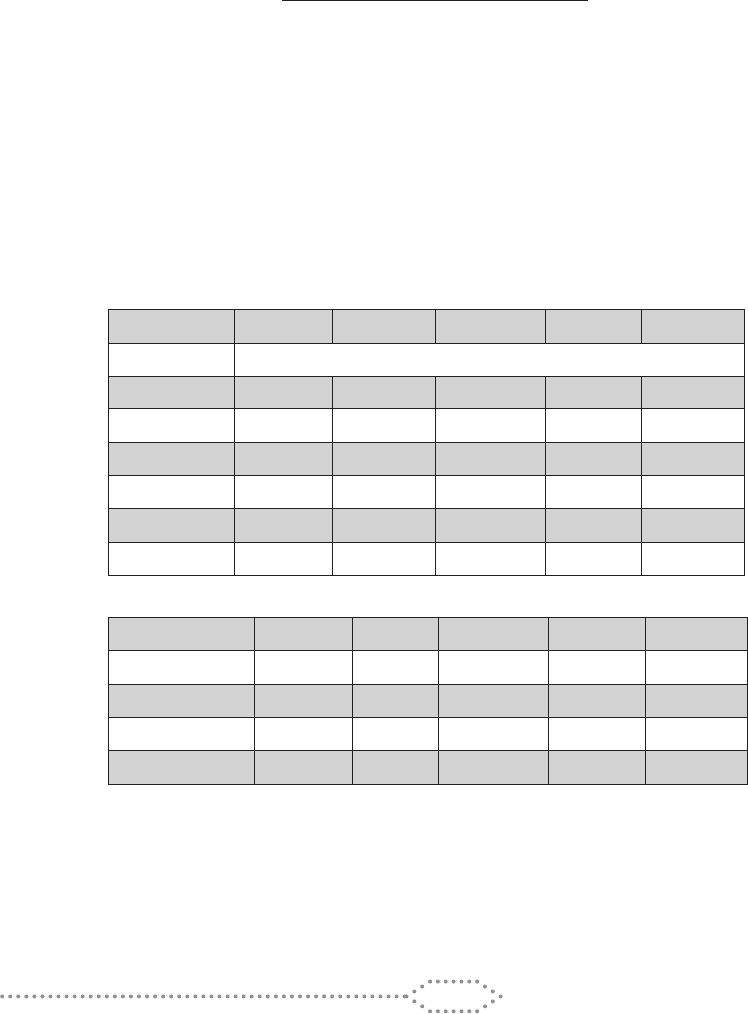
78
Part 5
ROUTINE PROCEDURES
Since good order and development of internal discipline are important to the
total education of the student, certain external measures are implemented at the USLS-
Integrated School. These external measures are called “routines” because it is expected
that once habits of good order become routinized, they become second nature to the
student. It is the goal of encouraging internal discipline that has brought about routine
school procedures.
I. DAILY TIME SCHEDULE
A regular class day starts with the Homeroom Period at 7:30 AM followed by the
academic classes at 7:50 AM.
For the Lower Grades, the schedule of dismissal is as follows:
Monday Tuesday Wednesday Thursday Friday
KINDER 7:30 AM – 11:00 PM / 11:30 AM – 3:00 PM
GRADE 1 3:10 PM 3:10 PM 2:20 PM 2:20 PM 11: 5 0 PM
GRADE 2 3:10 PM 3:10 PM 3:10 PM 3:10 PM 11: 5 0 PM
GRADE 3 3:10 PM 3:10 PM 3:10 PM 3:10 PM 2:20 PM
GRADE 4 4:00 PM 4:00PM 3:10 PM 3:10 PM 2:20 PM
GRADE 5 4:00 PM 4:00PM 3:10 PM 3:10 PM 2:20 PM
GRADE 6 4:00 PM 4:00PM 3:10 PM 3:10 PM 2:20 PM
For Upper Grades, the schedule of dismissal is as follows:
Monday Tuesday Wednesday Thursday Friday
GRADE 7 4:00 PM 4:00 PM 4:00 PM 4:00 PM 2:20 PM
GRADE 8 4:00 PM 3:10 PM 3:10 PM 4:00 PM 2:20 PM
GRADE 9 4:00 PM 4:00 PM 3:10 PM 3:10 PM 2:20 PM
GRADE 10 4:00 PM 4:00 PM 4:00 PM 4:00 PM 3:00 PM
Nevertheless, the school has designed special class schedules to accommodate within
the weekdays in-service training for teachers and student activities that demand
more time. Should there be deviation from the above stated schedule such special
schedule will be properly communicated to the parents/guardians through the
assignment notebook.

79
II. ENTRANCES AND EXITS
Gate #5– for Kinder students
Glass Door #1 – for Grades 1 and 2 AB students
Glass Door #3 – for Grades 2 CDE and Grade 3 students
Santuario Gate #7 & 8 – for Grades 4-6 students
Gate #1 or #2 – for Grades 7 students
Gate #5 – for Grades 8-10 students
III. BEFORE CLASSES BEGIN
A. Lower Grades
Students may enter their respective class rooms before the time. They are to
proceed to the classrooms in an orderly manner as soon as the bell rings. Religious
and Reach Out Committee (RROC) leads the Rosary at 7:00 AM.
B. Upper Grades
Students enter their respective classrooms when grill gates and classrooms are
opened at 7:20 AM while waiting for the opening of classrooms, students may
wait at the following areas: (Canteen, UGCC, upper grades lobby, RDJ Library,
umbrella huts, etc.). Proper order and respect for the academic atmosphere of
the school should be adhered to, therefore, students are expected to conduct
themselves well at all times.
IV. FLAG CEREMONY
Flag ceremony is held at the Quadrangle and Primary Covered Court for the Lower
Grades and Covered Court for the Upper Grades every Monday and/or Friday. The
bell is rung at 7:30 AM to signal the students to form their lines and then proceed
to the venue in an orderly manner. During the rest of the week, the ag ceremony is
done in their respective classrooms through the public address system.
V. HOMEROOM PERIOD
To foster a close interactive relationship between Homeroom Adviser and the class,
a 20-minute Homeroom Activity program in the morning of Tuesday to Thursday is
scheduled. The Homeroom Activity program emphasizes the development of Lasallian
attributes among students. Another 10-minute homeroom meeting takes place every
afternoon before classes are dismissed.
VI. PRAYERS
A prayerful atmosphere should pervade the school throughout the day. As such,
every class period begins and ends with a prayer.
The teacher or a student begins with “Let us remember that we are in the Holy
presence of God” ”Let us adore Him” followed by the sign of the cross. The prayer
leader intones a spontaneous prayer or a memorized prayer. At the end of the
prayer, the traditional prayer invoking St. La Salle is said “St. John Baptist de la Salle”
– “Pray for us”, “Live Jesus in our hearts” – “Forever”.

80
The MORNING OFFERING is prayed immediately before the ag ceremony.
The ANGELUS and BLESSING BEFORE MEALS are prayed before the lunch
break.
The PRAYER AT THE END OF THE DAY is prayed before dismissal in the
afternoon.
The PRAYER BEFORE AN EXAM is prayed during the quarterly examination
days.
VII. CLASS ATTENDANCE
A. ATTENDANCE PROCEDURE
The class secretary is in-charge of checking the class attendance and indicates
this on the Attendance Sheet. Every period the subject teacher rechecks
the attendance and afxes her/his signature to conrm the absence. The
Attendance Sheet with attached excuse letters is submitted to the DFO by the
class secretary for recording after the last period in the afternoon.
B. LETTER AFTER AN ABSENCE
A letter regarding the absence addressed to the DFO/Homeroom Adviser
shall be required before a student is allowed to attend classes. The letter
(which is found at the back of the Student Handbook) should be prepared and
signed by the parent/guardian. The letter should be given to the homeroom
adviser during the homeroom period/5th period subject teacher (after being
absent in the morning). The adviser then gives it to the DFO. A phone call
or facsimile is not a substitute for this letter. A student without the letter will
be sent to the DFO. Only signatures of parents/guardians appearing in the
Personal Data Sheet will be recognized.
C. EXCUSE LETTER AND MEDICAL CLEARANCE/ CERTIFICATE
A student who has been absent for three or more days due to illness must
secure a clearance from the school physician prior to admission to class or
submit a Medical Certicate with the inclusive dates of connement and the
reason for such, together with an excuse letter, to the class adviser to be given
to the Discipline and Formation Ofcer.
VIII. PASS TAGS
A. Lower Grades
A teacher’s pass is issued to a student seeking permission to leave the class.
The tag should immediately be returned to the teacher upon the student’s
return to the class.
B. Upper Grades
1. Each homeroom is issued a pass tag and a logbook which a student can
use in going to the comfort rooms.
2. In going to the clinic, the student logs his/her name in the Clinic Record
Book at the Level Vice Principal’s ofce and is then issued a Clinic Slip

81
in exchange of his/her class pass tag. From the Clinic the student gets
his/her pass tag and returns to the classroom with the Clinic Slip.
3. A Level Vice Principal’s tag is issued to any student who has to go
beyond the high school premises (Main Ofce, Main Clinic, Cashier,
etc.) for an errand or valid personal reason during class hours.
A student is held responsible to return the pass tag immediately
after use.
IX. RECESS AND LUNCH BREAKS
A. Lower Grades
1. During lunch time, Grades 1-3 students are encouraged to eat lunch
inside their classroom together with the advisers.
2. Students may also eat at the Canteen area or Primary Covered Court
area by themselves. Parents and guardians are NOT allowed to stay
inside the campus at lunch time.
3. For students who wish to leave the campus during lunch break, their
ID’s will be inspected by the Security Guard for the Lunch pass. NO
LUNCH PASS NO EXIT.
4. Students are prohibited to eat lunch at the Main Chapel area.
B. Upper Grades
1. Students may either bring their own lunch or avail themselves of the
canteen services provided by the school. Only students with “Lunch
Pass” indicated in the school ID are allowed to take their lunch off
campus.
2. Student may take their snacks or lunch at the Upper Grades cafeteria,
the Upper Grades covered court, along the corridor on the ground
oor and in other designated areas. Eating and drinking are not
allowed in the classrooms, stairways and other corridors.
X. CALLING OUT STUDENTS FROM CLASS
A. Only the Principal, VP-Academics, Level Vice Principals, DFO, and Guidance
counselors may call a student out of class. An appointment slip is presented to
the teacher to inform him/her of the need for the student to leave the class.
B. A student who is taking a test or a quiz may NOT be called out of his/her class
unless the slip is marked.
XI. DEPARTURE/OFF-CAMPUS PERMIT
A student who has to leave the school campus during class hours due to illness or
otherwise, is required to get a departure of off-campus permit from the Level Vice
Principal or the Discipline Formation Ofcer and present this to the Security Guard
posted at the school gate.
Likewise, a student who knows in advance that he/she is to leave school during

82
class hours for personal reason or a previous scheduled appointment has to present a
letter from his/her parents or guardian to the DFO prior to the issuance of a permit.
XII. ADVANCE VACATION OR BREAK FROM SCHOOL
Permission to leave school at an earlier date before the regular school breaks
(semestral, summer, Holy Week, Christmas) shall not be granted except for valid
reasons such as emergencies or the like. The request is addressed to the Principal or
Vice Principal for Academics for approval under certain conditions.
XIII. BIRTHDAYS IN SCHOOL (for Lower Grades)
Request for simple birthday celebrations should be coursed through the Ofce of
the Level Vice Principal. A birthday contract/agreement should be signed at least
three (3) days prior to the celebration. Only simple snacks (no loot bags or party fun
wares) to be given during dismissal will be allowed.
XIV. SPECIAL REMINDERS
a. Warning bell is done for the students to manage time properly. When warning
bell has rung, the students should form their line along the corridors while
waiting for their teachers.
b. For safety purposes, students especially in the Lower Grades, are discouraged
from running.
c. To avoid losses, the students should place their things inside the room, not
along the corridors after dismissal.
d. Students should keep right when walking along the corridors.
e. Students are not allowed to touch any decoration or the bulletin board inside
or outside the classroom unless given special instruction.
f. Everyone should practice CLAYGO (Clean As You Go) wherever they are.
g. The teacher may assign responsible students to watch over the things of their
classmates or should lock the room when they go out.
h. Students are discouraged to solicit or accept party offers from establishments
during class hours or within the campus.

83
Part 6
STUDENT ACTIVITY PROGRAM
The Student Activity Program is designed to complement and support the existing academic
offerings through a wide range of student activities that aims to:
1. develop students’ responsibility, leadership, initiative and sense of
interdependence;
2. discover and develop students’ varied abilities and interests;
3. discover and enhance students’ potentials and talents;
4. encourage students’ involvement in school and community-related activities;
5. encourage and allow for maximum student responsibility and freedom in
initiating, organizing, planning and executing student activities; and
6. propel students’ spiritual, social, and civic consciousness towards creative
thinking.
A. Guidelines for Student Participation in Ofcially Recognized Co-
Curricular Activities
1. Student representatives are generally to be recommended by teachers
or moderators concerned with the activity when warranted.
2. Recommendations are to be screened by the Moderators, Level Vice
Principal, and Vice Principal for Academics.
3. The Principal makes the nal decision.
4. Teachers are notied of the student’s absence through either the Daily
Bulletin or note on the faculty bulletin board.
5. Students need not make up for quizzes missed. This should not be taken
against them. However, students are responsible for the subject matter
missed in preparation for any test which may be given after their
absence.
B. Student Activities
1. Leadership Orientation and Training Seminar (LOTS)
The Leadership Orientation Training Seminar (LOTS) is a leadership
camp aimed to specialize character development and formation of
servant leaders. This activity focuses on developing the leadership
skills and value formation of the student leaders with emphasis
on value-driven leadership on Faith, Service and Communion. The
different organization heads and class homeroom ofcers are invited
to participate in the said activity to discuss and share ideas on social

84
awareness and community involvement. It aims to enhance and
challenge critical thinking, cooperation, unity, camaraderie, problem-
solving skills, condence, initiative, independence, compassion, and
humility: qualities that each servant-leader possess.
Infused with faith, zeal for service and communion in mission,
passion drives the Lasallian student leaders to utilize their essential
learnings in the Leadership Orientation Training Seminar in order to
propagate positive affairs both inside and outside the campus.
2. SAC School Projects
The Student Affairs Council (SAC) School Projects aims to develop
student leadership potentials, practice good citizenship, promote
harmonious relations throughout the school, and by provide orderly
and wholesome activities to promote the general welfare of the student
body. The following school projects were implemented by the SAC over
the years:
- Flag Ceremony Assembly preparations
- Animo Merchandise
- Self-Defense Training Workshop
- Alay-Kapwa: Saturday Reach-Out Activities
- Animofest and Lasallian Week
- Lasallian Teacher’s Day Celebration
- Paper Bin Project
- Interbarkada Game events
- Assistance of school events sponsored by different units
o Mikel Lovina Sportsfest
o IS Balayan reach-outs
o Department activities
o IS CELAM activities
o Level-initiated programs
3. Student Club/Organization-Initiated Activities
To further train students on leadership, community-building, teamwork,
responsibility, and creative and critical thinking, the school offers
various clubs from Grade 2 to 6 in the Lower Grades and from Grade
7 to 8 in the Upper Grades. Grade 9 and 10 students may join the
existing student organizations and attend to these activities outside of
their regular class schedules.
Clubs are categorized as Service Clubs, Sports Clubs, Interest
Clubs and Academic Clubs. Students may enlist in the club of their
choice at the beginning of the school year. The Ofce of the Level Vice

85
Principal facilitates the grouping of the students in the different clubs
with assigned teacher-moderators.
These clubs regularly meet on a Thursday to plan and implement
their approved activities to advance their avowed purposes and goals.
Clubs and organizations initiate, sponsor, or organize varied activities
all throughout the school year.
4. Invitational Events/Activities
a. Boys and Girls Week Celebration
An event organized by the Rotary Club members of Bacolod City
is aimed to instill the true essence of being a public servant within
each and every educated youth. It allow student participants to
work side by side with real government ofcials and empower
young leaders to be more involved in the city’s projects. The
participants are also recognized as the future leaders of the next
generations to come and serve as a training ground for aspiring
government ofcials. Student leaders from different schools
undergo three stages to qualify for the government positions.
Afterwards, participants are granted a position to either act
as Councilor, Vice-Mayor or Mayor of Bacolod City and other
various sectors and departments of the local government. One
learns more about the duties of certain government ofcials and
the way in which a local government operates.
b. Three Outstanding Student Council Awards
TOSCA (Three Outstanding Student Council Awards) is an award
giving body sponsored by the Bacolod JCI acknowledging work
done by student councils of Bacolod City. The vision and passion
of every student council leaders in the participating schools are
experienced, heard and admired by a board of judges, who
decides whoever belongs to the top three. Special advocacy
awards are given attention to by the student councils are being
identied: business leader, values formation, community service,
environmental awareness, and science and technology, sports,
and cultural arts.
TOSCA aims to recognize, inspire, and motivate future
leaders in the society, to do more than just in a school-level.
c. Saceda Youth Leadership Camp (SYLC) /Saceda International
Program in Asia/Australia (SIPA)
The Integrated School believes in the capacity of the students
to learn and discover new opportunities through international
experiences that they can apply in life, as young individuals of
today’s generation. Thus, the school has been in partnership with
SYLC/SIPA for its Internationalization Program.

86
Founded by Dr. Dave G. Saceda, SYLC/SIPA, an inaugural
leadership development program, seeks to study the value
systems and cultures of different countries and learning about
the brilliance of cultural diversity. Moreover, the program helps
students foster understanding of cultural differences by imparting
knowledge and values of the Lasallian Community into their
activities in the program.
Furthermore, the program aims to develop the sense of
independence and responsibility, as well as, to become much
more open minded and sensitive about people having different
cultures and beliefs.
C. STUDENT ORGANIZATIONS/CLUBS
The Student Affairs Council (SAC)
The major organization of the Integrated School is the Student Affairs
Council (SAC) which aims to develop in students’ leadership potentials, practice
good citizenship, promote harmonious relations throughout the school, provide
orderly direction to the school activities and promote the general welfare of
the school.
The council ofcers are composed of the president, vice president,
secretary, treasurer, PRO, grade level governors, vice governors, batch
secretaries and treasurers and homeroom mayors, and appointed ofcers (in
the case of the Lower Grades).
SAC Vision-Mission Statement
WE, the students of the USLS-Integrated School, envision a school where the
Lasallian values of faith, service and community are infused into the spirit of each and
every Lasallian student; where the habits of moral values and discipline are put into action
to build a society lled with love, respect, understanding and acceptance of all people;
and where all Lasallian students inspire one another to be the change that our world needs.
Thus, we commit to achieve our goals through our collective and collaborative
exercise of ethical and servant leadership in school and society.
STUDENT AFFAIRS COUNCIL (SAC) 2019-2020 EXECUTIVE BOARD
Lower Grades Executive Board
President Catherine Therese Q. Gatuslao
Vice President Tiffany Joy M. Desengaño
Executive Secretary Christine Michaella Angeli O. Villa
Executive Treasurer Mikaela Angela V. Rubica
Public Relations Ofcer Julia Frances D. Ferrer
Level Governors
Grade 2 Governor Andre Carlo F. Britanico

87
Grade 3 Governor Maria Julia Otilia G. Lacson
Grade 4 Governor Franzis Andrea H. Ando
Grade 5 Governor Justin Paul G. Mendez
Grade 6 Governor Gian Carlo M. Barcoma
Upper Grades Executive Board
President Edrian Kyle B. Verzosa
Vice President Lou Marcial M. Cuesta
Executive Secretary Marielle Natasha C. Judith
Executive Treasurer Edriana Michaela C. Magallanes
Public Relations Ofcer Cindy Lou T. Samson
Level Governors
Grade 7 Governor Bernadette Therese R. Deldig
Vice Governor Sofea S. Garzon
Secretary John Matthew S. Eriso
Treasurer Tychicus Jairus T. Tarayao
Grade 8 Governor Leon Antonio C. Besar
Vice Governor Gianna Angela M. Severino
Secretary Ma. Liana Jeanber S. Eriso
Treasurer Leila May C. Sorreño
Grade 9 Governor Geneen Louise F. Gelvoleo
Vice Governor Jason Paul G. Mendez
Secretary Kelly Gabriel S. Occeño
Treasurer Cindy Pauline C. Pablador
Grade 10 Governor Emmanuel N. Salgado II
Vice Governor Jahmai Mar A. Alarcon
Secretary Jasmine D. Mahilum
Treasurer Bianca Manuela P. Diva
STUDENT AFFAIRS COUNCIL (SAC)
PAST PRESIDENTS
A. Lower Grades
2018 – 2019 Bernadette Therese R. Deldig
2017 – 2018 Kevin William M. Castro
2016 – 2017 Sean Cedric M. Castro
2015 – 2016 Lou Marcial M. Cuesta
2014 – 2015 Nympha Isabelle C. Santillan
2013 – 2014 Eazel T. Sevilleno

88
2012 – 2013 Justin Mikael G. Moreno
2011 – 2012 John Christopher G. Orbista
2010 – 2011 Rhea Mae M. Villalba
2009 – 2010 Leandro Rafael A. Marchadesch
2008 – 2009 Dominique Y. Abelido
2007 – 2008 Mark P. Nimanand
2006 – 2007 Mario Etorre Jose A. Marchadesch
B. Upper Grades
2018 – 2019 Brian Paul Mesada
2017 – 2018 Kent Benedict G. Villaor
2016 – 2017 Justin Mikael G. Moreno
2015 – 2016 Bryan J. Bermejo
2014 – 2015 Lance Ryan J. Villarosa
2013 – 2014 Arielle L. Estrañero
2012 – 2013 Vanya Fatima Castor
2011 – 2012 John Paul Fabricante
2010 – 2011 Mario Etorre Jose A. Marchadesch
2009 – 2010 Neil Renan D. Juntado
2008 – 2009 Marian Grace D. Claver
2007 – 2008 Amelia Anna Maria R. Taruc
2006 – 2007 Roseller C. Ciocon Jr.
2005 – 2006 Federico Manuel R. Locsin IV
2004 – 2005 Alan Kristofer F. Motus
2003 – 2004 Delman P. Alagao
2002 – 2003 Hector Gregory A. Benedicto
2001 – 2002 Matthew Victor Anthony O. Gamboa
2000 – 2001 Antonio Eduardo R. Taruc
1999 – 2000 Allan Paolo Felix S. De Guzman
1998 – 1999 Rocky Anthony A. Puentevella
1997 – 1998 Miguel Francisco L. Leonardia
1996 – 1997 Cesar B. Regino Jr.
1995 – 1996 Bernardo A. Bernardo
1994 – 1995 Rudyard S. Hipe
1993 – 1994 Edwin J. Miraor Jr.
1992 – 1993 Caesar Leonides A. Lirazan
1991 – 1992 Dennis Michael B. Cuaycong
1990 – 1991 Christopher Pio V. Lopez
1989 – 1990 Paul Benedict Ian H. Fernandez

89
1988 – 1989 Juan Alfonso D. Suarez
1987 – 1988 Mario Carmelo V. Lopez
1986 – 1987 Pete Raymund V. Deln
1985 – 1986 Luis Y. Osmeña
1984 – 1985 Jose Ma. G. Montinola
1983 – 1984 Raymund Peter Y. Osmeña
1982 – 1983 Angel Gemini B. Salva
1981 – 1982 Roberto Jose R. Jimenez
1980 – 1981 Raymund D. Villanueva
1979 – 1980 Emilio J. Gayoso
1978 – 1979 Jose Edgardo E. Mirasol
1977 – 1978 Dennis L. Valdez
1976 – 1977 Alfonso “Diding” F. Gamboa
1975 – 1976 Jose Salvador Mirasol
1974 – 1975 Rafael “Juny” Lizares Jr.
1973 – 1974 None
1972 – 1973 Gregorio Kilayko
1971 – 1972 Paul F. Lacson
1970 – 1971 Alan A. Ayco
1969 – 1970 Jessie Benedicto
1968 – 1969 Antonio C. Yulo
1967 – 1968 Jose Ma. T. Ascalon
1966 – 1967 Dennis B. Ditching
1965 – 1966 Ricardo Gallaga Jr.
1964 – 1965 Monico O. Puentevella
1963 – 1964 Alfredo G. Bustamante
1962 – 1963 Salvador Lacson
1961 – 1962 Jimmy G. Golez
1960 – 1961 None
1959 – 1960 None
1958 – 1959 None
1957 – 1958 Felix Suarez
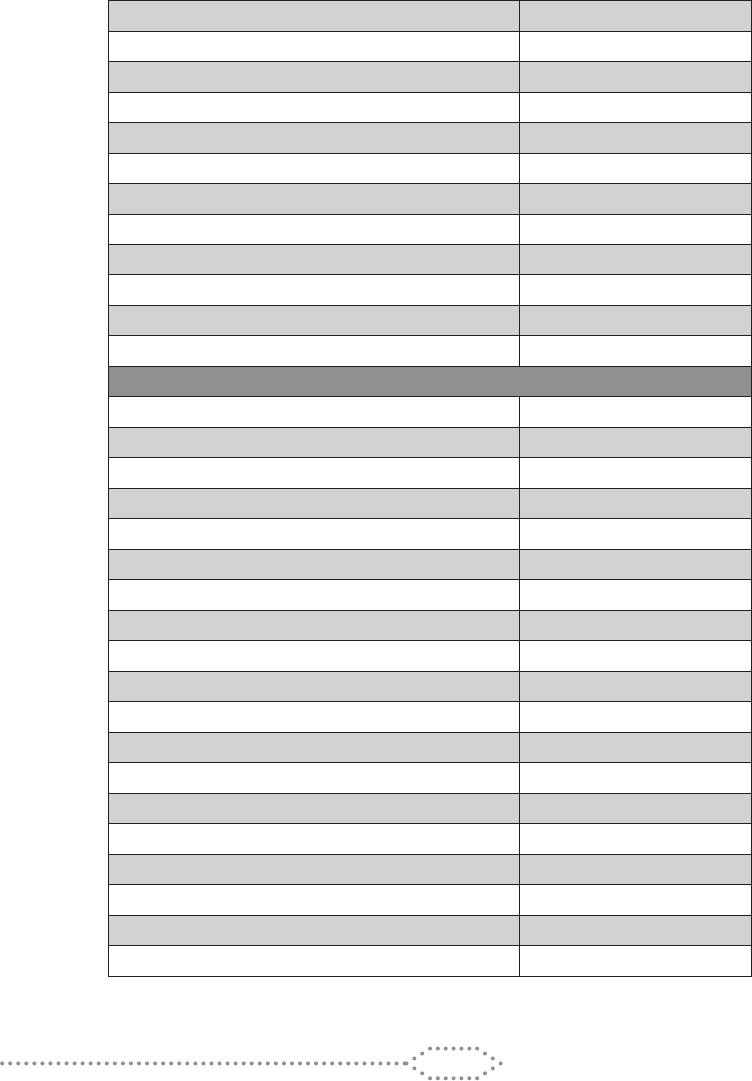
90
RECOGNIZED CLUBS AND ORGANIZATIONS SY 2019-2020
LOWER GRADES LEVEL
CLUBS MEMBERSHIP
Badminton Gr. 2 & 3
Creative Hands Gr. 2 & 3
Kids For Christ Gr. 2 & 3
Lasallian Earth Warriors (LAW) Gr. 2 & 3
Lasallian Geos Gr. 2 & 3
Numja Kids Gr. 2 & 3
Sporty Kids Gr. 2 & 3
Star Scouts Gr. 2 & 3 Girls
The Mob Gr. 2 & 3
Travel Zone Gr. 2 & 3
Words & Stories Gr. 2 & 3
Achievers’ Circle for Excellence (ACE) Gr. 4 & 6 selected
Badminton Gr. 4-6
BSP Gr. 4-6
GSP Gr. 4-6 Girls
Larong Pinoy Gr. 4-6
Musika Gr. 4-6
Numja Gr. 4-6
Rated PG Gr. 4-6
Science Wizards Gr. 4-6
Service Scouts Gr. 6 Boys
Soduko Gr. 4-6
Spikers Gr. 4-6
Sweat Out! Gr. 4-6
Table Tennis Gr. 4-6
UCPM Gr. 4-6
Writer’s Pool (English) Gr. 4-6
Writer’s Pool (Filipino) Gr. 4-6
Luntiang Tanglaw Lower Grades
Green Beacon Lower Grades
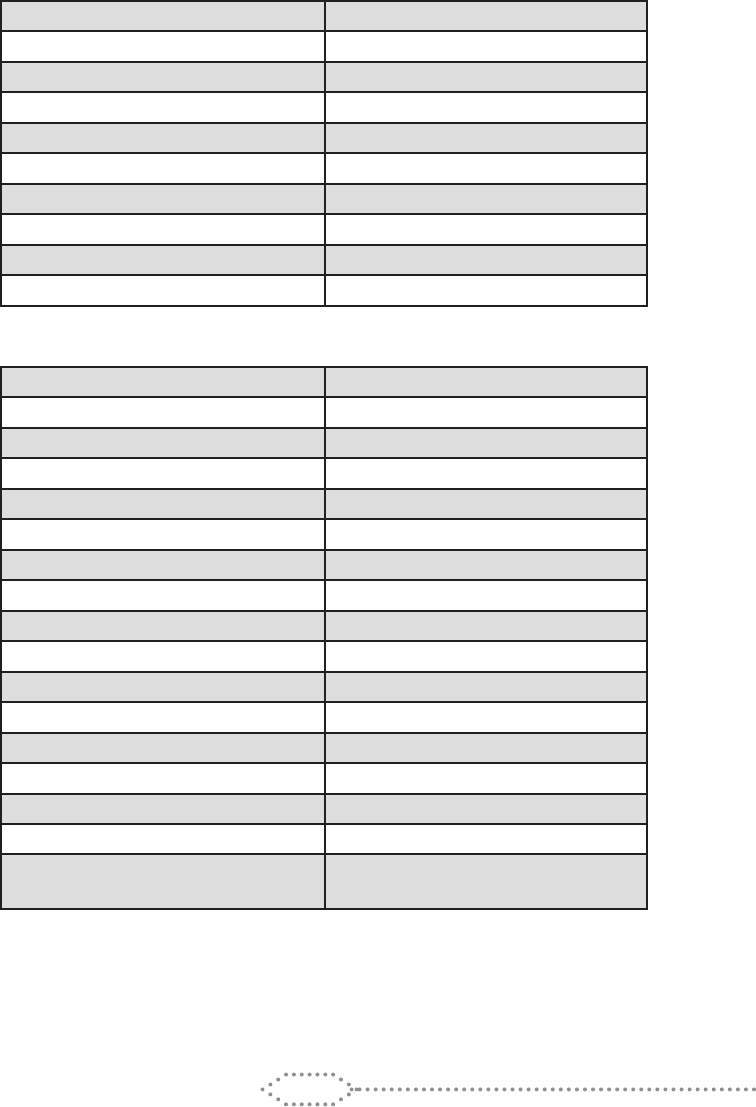
91
UPPER GRADES (FOR GRADES 7-8 ONLY)
CLUBS CLUBS
Artists Pool IS Praisers and Acolytes
Badminton Photography
Basketball Reading Hub
Chef’s Circle Robotics Club
Chess Table Tennis
Computer Volleyball Boys
Dance Volleyball Girls
Euler’s Circle Young Educators Society
IS Chorale
ACCREDITED STUDENT ORGANIZATIONS
NAME OF ORGANIZATION UMBRELLA ORGANIZATION
Les Femmes c/o CLE Department
IS Drumbeaters
Multer Productions
Campus Peer Ministry c/o IS CELAM Ofce
Amity Youth c/o CAT
Junior Red Cross Kabulig
Lasallian Peace Corps Kabulig
Young Citizens for Environmental Rescue Kabulig
Gawad Kalinga Kabulig
Bahay Pag-asa Volunteers Kabulig
Little Voices Kabulig
Drug Watch Kabulig
Interact Kabulig
Explorer Scouts
Girl Scouts of the Philippines
Photography (for honorary members in
Grade 9-10)

92
Part 7
ACADEMIC SUPPORT SERVICES
I. INTEGRATED SCHOOL CENTER FOR LASALLIAN MINISTRIES
(IS CELAM)
The Integrated School Center for Lasallian Ministries (IS CELAM) extends its services
to the whole Lasallian community. It provides “experiences” of God for students
which complement Christian Living Education classes. The program aims to foster
holistic development of the students, guided and inspired by the charism of St. John
Baptist de La Salle, giving them opportunity to share their time, talent and treasure
in service to Christ as demonstrated through the school community and outreach to
the less-privileged in our society.
The students are provided with opportunities for:
a. Spiritual / religious formation through retreats and recollections (as per
schedule), and paraliturgical services, liturgical and sacramental services;
b. Formation and training of Peer Ministers;
c. Intensication of Lasallian mission in youth ministry;
d. Involvement in the Diocesan activities;
e. Vocation accompaniment;
f. Altar Servers, Lectors, Commentators.
II. IS BALAYAN
The IS Balayan, previously known as the Community Services Center serves as
a venue for the students to be exposed to the reality of daily living in welfare
institutions, public schools, urban squatter areas and puroks, and in the process, elicit
in them the desire to fulll the need for creative and meaningful involvement so as to
meet some of the social needs of the marginalized communities.
The underlying thrust of the program is the inculcation of Christian values and
moral principles which propel each individual to be more conscious of the needs
of his fellowmen and contribute one’s talents and wealth for the upliftment of the
quality of life in the community.
It provides the students with concrete and meaningful opportunities to relate
school experiences to one’s immediate community, applying the theories gained from
the different subjects taught in school.
III. THE GUIDANCE SERVICES
The Philosophy of the Integrated School Guidance Services Center is to assist all
students to acquire the academic, career, personal and social skills to achieve the fullest

93
educational potential and successfully manage their lives as healthy, understanding,
responsible, competent and productive citizens who respect themselves and others
As a service unit, a well-dened and a well-organized developmental
Guidance Program is designed to maximizes the students’ growth and development
inspired by the charism of our founder St. John Baptist de La Salle.
A. Core Services and Programs
1. Counseling
The “heart” of the program. It is geared towards providing opportunities
for the students to understand themselves better in order that they may
become capable of self-direction and self-improvement.
2. Testing
It is an evaluation and assessment service. It is meant to determine/
predict students’ academic potentials, capabilities and aptitude as
well as personality estimates. Data gathered are used for counseling,
career assessment, placement, statistical studies and researches.
3. Individual Inventory
It aims to document and collect information about the student’s test
results, personality estimates, family and behavior appraisal among
others that may aid to understand and support in their growth and
development.
4. Information
Group Guidance and Information
a. Group Guidance Program. It promotes students’ awareness
and understanding on issues related to personal, emotional and
social development appropriate to developmental stages and
enrichment activities.
b. Career Guidance Program. It provides a comprehensive career
program properly dened for each grade level to help assess
students’ abilities, skills and interests as part of life – career
planning process and help students widen a broad understanding
of the world of work for them to make wise future career decisions.
c. Orientation Program. It offers different kinds of orientation
programs which provide students with wide range of knowledge
and information for better academic preparation and help
develop the wholesome school life adjustment.
d. Special Program for OFW. This is designed to provide programs
and activities for the children of overseas workers to develop the
ability to share and communicate their feelings, self-awareness
and their capacities to cope with life challenges. Furthermore, it

94
is a good avenue for the children to share and learn from each
other. The fact that they are all children of migrants undergoing
the same experience resulted in developing a self-help group.
5. Placement
It aims to provide students with complete support, guidance and
streamline application process to an appropriate grade level
and suitable career choices in consonance with their skills and
interest to achieve academic goals. This process is focused in
determining appropriate options that are a “best t” for each
student’s capabilities, academic, social and emotional aspects.
6. Follow-Up
This service is designed to secure essential information that is
necessary for evaluating and planning the many phases of the
school program. Likewise, it helps determine the adequacy and
sufciency of the services and programs extended in meeting the
needs of its clientele.
B. Related Services and Programs
1. Research and Evaluation
It is geared towards a systematic gathering of data in order to come up
with a quantitative explanation of hard facts. Information gathered may
provide further knowledge and understanding of the data as basis for
planning and improving instruction and services.
2. Consultation, Referrals and Recommendations
Provides the venue for healthy exchange of information related to the
behavior, attitude, career decision making and academic concerns of
the students when teachers, counselors, parents. School administrators
and specialists involvement and intervention is desired.
3. Service to Administrators, Teachers and Parents
A well organized and functional service that serves the Administrators,
faculty and parents to establish and maintain an open and smooth
lines of communication which can bring an effective working relation
and better coordination of effort in maximizing the education benets
of all students. Furthermore, help facilitate guidance activities and in
– service training for teachers in enhancing personal growth and self –
improvement and enhance good parenting skills for parents.
4. Outreach
It is a special service rendered/extended to the Lasallian community, La
Salle supervised schools, other schools and outside communities, sharing
extra time and expertise of the counselors.
IV. LIBRARIES

95
A. LETTY L. MONTELIBANO (LLM) LIBRARY
The LLM Library is an Educational Learning Resource Center that provides
materials, facilities and services that support the teaching-learning process.
1. SERVICE HOURS:
* Monday – Friday 7:00 A.M. - 5:00 P.M.
2. SERVICES OFFERED TO FACULTY AND STUDENTS
a. Reader’s Education
* Library Instruction Program (Kinder to Grade 6)
* Library Orientation Program
b. The Computerized Library System Services
* Book Circulation
* Online Public Access Catalog
* Inventory
* Cataloging and Classication
c. Cybernook
* Online research
* Printing services
d. Current Awareness Services
* Bulletin Board Display
* Book Display
* Exhibit
* Bibliographic List Display of New Acquisition
e. Supervised Class Research
f. Reference and Information Service
g. Recall and Reminder
h. Acquisition
i. Acquisition recommendation
j. Mobile Periodicals
k. LIBREW Corner
NOTE: The detailed policies and guidelines of the LLM Library can be found in
the Library Handbook.
B. RAYMUNDO DIZON, JR. (RDJ) LIBRARY
The RDJ Library is a learning resource center with a wide range of print
materials, electronic resources, and online databases to support the school’s
vision, mission, goals and objectives. These materials are well-organized to
facilitate easy access to the users.
1. SERVICE HOURS
Monday to Friday 7:00 AM to 5:00 PM
2. SERVICES OFFERED TO FACULTY AND STUDENTS

96
a. Reference and Information Service
b. Reader’s Education
* Faculty Orientation
* Students Orientation
* Library Instruction
c. Reader’s Advisory
d. Reference Query
e. Literature Search
f. Current Awareness Services
* Bibliographic or Reading List
* New Title Lists
* IS Daily Bulletin
* Table of Contents (TOC)
* Book Exhibits/Display
Bulletin Board
* Updated Library Webpage
* Updated monthly features of the TV Screen inside and
outside the Library
g. Acquisition
h. Automated Circulation System
* Entrance log-in
* Cataloging and classication
* Circulation
* Inventory
* Reports Generation
* Online Public Access Catalog
* Security Gate
i. Indexing
j. Interlibrary Loan
k. Internet and Wi-Fi Access
l. iPod and Tablet Circulation
m. Library Reservation
n. LiBrew Reading Corner
o. Mobile Periodicals
p. Printing
q. Recall
r. Reminders
s. Reservation for Classroom Use

97
t. Supervised Class Research
u. Technical Services
v. Vertical File and Newspaper Clippings
The detailed policies and guidelines of the RDJ Library can be found online at
the USLS-IS Library Webpage @ http://usls.edu.ph/is-library
V. THE MULTIMEDIA CENTERS
The Multimedia Centers of both Lower and Upper Grades are support units which
provide the academic community with adequate equipment, non-print instructional
materials, facilities and services to complement formal instruction and co-curricular
activities as well.
1. SERVICES HOURS
Monday - Friday 7:30 AM to 4:30 PM (No noon break)
SERVICES OFFERED
a. Assistance to Classroom Instructional Presentation
b. Equipment and AV Materials Circulation
c. Equipment Reservation
d. Maintenance of AV Equipment
e. Assistance to Extra Curricular Activities
f. Photo and Video Documentation Coverage of School Activities
g. Classroom Film Viewing
h. Acquisition of Equipment and AV materials.
The detailed policies and guidelines of the Multimedia Centers can be
accessed online through the USLS-IS Library webpage @ http://usls.edu.ph/
is-library.
VI. THE COMPUTER CENTERS
The Computer Center is the laboratory venue of the Computer Education Program. It
provides the needed services and equipment which would better serve the students.
The laboratory is located at the second level of the Upper Grades building and
another laboratory for the lower grades located in front of the LLM Library.
SERVICE HOURS: 7:30 AM – 4:30 PM Monday to Friday
SERVICES OFFERED:
* Prepare the laboratory for the computer classes and other computer-related
activities.
* Install the operating system and software application required by the class
level
* Organize the computer, user account and data stored in personal directory or
folder.

98
* Maintain the services of computer system and other related materials.
* Facilitate remediation time or consultation period as instructed by the subject
teachers and approved by the Department Chair
* Conduct minor repair of computers and other peripherals as needed.
* Install cables/networks.
* Maintain the general upkeep of the laboratories.
VII. SCIENCE LABORATORIES
The Integrated School Science Laboratories are composed of the Junior High School
(Biology, Chemistry and Physics laboratories) and the Lower Grades laboratories.
There are two stockrooms; one is located on the second oor. It is the main storage
for chemicals and glassware. The other is on the third oor annexed Chemistry Lab
for easy access and safe handling.
The Laboratory ofce is located on the third oor and is manned by a
Laboratory Coordinator and an assistant.
The Science Laboratories aim to support the Science department achieve its goals
and objectives by:
1. providing venue for experiment and Science investigation,
2. preparing facilities, materials and supplies during laboratory experiments,
3. providing adequate supplies, materials and facilities,
4. assisting Science teachers in the conduct of experiments, and assisting in
the use of laboratory apparatus and equipment.
VIII. HEALTH SERVICES CENTER
A. Medical Consultation
Procedures
1. Any member of the USLS Community who is not feeling well or sick shall
go to the clinic for consultation.
2. The physician on duty shall obtain the history of present illness,
examine the patient, and make an initial diagnosis and advice the
patient regarding his/her conditions.
3. The physician shall prescribe the appropriate medication to the
patient.
Policies and Guidelines
1. A request or consultation relayed through a phone call shall not be
entertained.
2. The clinic provides basic and emergency services within its resources.
3. Denitive management and treatment should be done with the patients’
own personal physician or in the hospital.

99
4. The clinic provides beds for temporary rest and comfort of patients. As
determined by the physician or nurse on duty, the patient may be sent
home referred to a specialist, brought to a hospital or allowed to go
back to class.
5. Only patients are allowed to rest in the clinic. No companions or
watchers are allowed to stay.
6. When there is injury, rst aid treatment is administered immediately.
7. No intramuscular or intravenous medications will be given in any of the
three clinics.
8. The Health Services Center is not well equipped for treatment of
anaphylactic shock.
9. The clinic is not obligated to give the full course of medication, only a
starter dose, if available, is provided. Subsequent medications are the
responsibility of the patient.
10. Emergency cases are to be brought to the hospital, accompanied by the
school nurse. In cases where emergency occurs after regular working
hours of the Main Clinic and the Upper Grade Clinic, the nurse at the
College Satellite Clinic will accompany the patient to the hospital.
Parents or guardians of the student patient will be notied immediately.
B. On Nebulization
Procedures
1. Patient shall seek personal consultation at the Clinic.
2. Upon consultation, the physician on duty shall examine the patient and
based on breathing patterns or the auscultatory ndings (“wheezing”),
nebulization maybe recommended and administered.
3. Re-evaluation of the patient after nebulization shall be done.
4. If no relief was noted, the patient shall be advised to go to the hospital
for further management.
Policies and Guidelines
1. The clinic can only provide within its resources, the initial dose of nebule
available for nebulization.
2. For those patients who are already on nebulization treatment, it is
preferred that they bring their own mouthpiece and tubing and present
latest doctor’s prescription/order prior to nebulization.
3. Patients bringing their own nebulizers and personal mist kits can plug
in their units at any of the available sockets at the rest areas in any of
the clinics in the campus.
C. On Sending Home
Procedures and Guidelines
1. When a patient enters the clinic, the physician or nurse on duty will ask
about the chief complaint and history of present illness.

100
2. The physician or nurse on duty will take the vital signs and assess the
patient.
3. After evaluation and assessment, the patient will be given rst aid
treatment, depending on the availability of the medicine.
4. If the patient is deemed necessary to be sent home, the nurse on duty
shall call and inform the Vice Principal’s Ofce, who in turn, will inform
the parent or guardian.
5. Meanwhile, the patient is advised to stay and rest in the clinic and will
no longer be allowed to go back to his/classroom.
6. Once the parent or guardian arrives at the clinic to pick up the patient,
the nurse on duty will give a discharge slip containing the nding,
medication given and recommendation.
7. A Kasanagan volunteer (to be informed by the Vice Principal’s Ofce
personnel), will get the things of the patient from his/her classroom and
brings them to the clinic. The said volunteer will also provide a signed
departure slip from the Vice Principal’s Ofce to the parent or guardian.
D. On Ambulance Transport to the Hospital
Procedures
1. The Health Services Center staff shall assess and monitor the patient’s
health status.
2. After assessment and monitoring, when found the need for further
medical care, ambulance transport shall be arranged.
3. The clinic staff shall directly call either the General Services or
Campus Internal Safety and Security Ofce guardhouse to check the
availability of the driver and ambulance prior to transport.
4. The clinic staff shall give out details to the driver or guard on duty the
needs of the patient and where to transport.
Policies and Guidelines
1. If the patients is a minor or from the Integrated School, parents are
notied prior to transport.
2. Once notied, the parents can decide which hospital to bring the
patient.
3. The parents may opt to fetch their patient at the clinic and proceed to
the hospital or may join in the ambulance for transport.
4. Emergency cases to be brought to the hospital will be accompanied by
the school nurse.
5. In cases where emergency occurs after 5:00 PM, the nurse assigned at
the college satellite clinic will accompany the patient to the hospital.
The satellite clinic will be closed pending the return of the nurse.

101
6. The university provides ambulance service when necessary.
E. Provision of a Medical Kit
Procedures
1. A written request addressed to the Medical Director when borrowing
a medical kit shall be submitted three (3) days prior to the issuance of
the said kit.
2. Upon issuance of the medical kit, the borrower shall sign in the logbook.
Policies and Guidelines
1. The medical kit should be returned to the clinic two to three days after
using.
2. In case the medical kit is lost or unreturned, the borrower is directed to
replace the medical kit container within one week.
3. There will be no issuance of medical kit without a written request.
F. Dental Services
Procedures
1. To avail of the dental services such as tooth extraction or temporary
lling, a dental check-up shall be conducted.
2. After dental examination and upon recommendation by the dentist
(either for tooth extraction of temporary lling), an appointment shall
be arranged prior to the procedure.
Policies and Guidelines
1. There will be no tooth extraction during the examination week.
2. The clinic will provide the local anesthetic prior to tooth extraction, a
hemostatic drug, and initial dose of analgesic after the procedure.
G. On Extra/Co-curricular Activities
Procedures
In extra/co-curricular activities (whether on or off campus), the faculty in charge
or moderator seeking the services of a nurse shall write a letter of request
addressed to the Director, at least one (1) week before the said activity.
Policy and Guidelines
Approval of request is subject to the availability of the nurse.
H. When Claiming Your Insurance
Procedure
1. When there is an occurrence of an injury or accident, the patient shall
be taken to the clinic.
2. The physician inquires the nature of the accident, examines the patient
and determines the extent of the injury.

102
3. After the assessment of the physician, the nurse shall determine the
scope of the medical insurance coverage.
4. The nurse shall gather the data, ll up the accident insurance form,
process and have it signed by the controller.
Policies and Guidelines
Policies and guidelines will be based on the existing accident insurance
provider of the University.
CLINIC HOURS and PHYSICIAN’S SCHEDULE
MAIN CLINIC
Monday to Friday 7:30AM to 5:00 PM
Saturday 8:00 AM to 12:00 NN
UPPER GRADES CLINIC
Monday to Friday 7:30 AM to 4:00 PM
PHYSICIAN’S SCHEDULE
Main Clinic
7:30 AM – 9:00 AM Daily
10:00 AM – 12:00 NN Daily
1:30 – 4:30 PM MWF
1:30 – 4:00 PM TTH
UPPER GRADES CLINIC
1:30 – 3:00 PM Tuesday/Thursday
SCHOOL DENTIST
Main Clinic
10:00AM to 12:00 NN Daily
1:30 to 3:30 PM

103
TEXT OF MEMORY EXERCISE
I am a Lasallian student. I am part of a very signicant community where everyone
is expected not only to improve himself/herself but also to inspire others to be better. I am
bound to uphold its regulations, respect its tradition and persevere to improve it. All of these
I will do as a gratitude to those who had come before me and create a better environment
for those who would come after me.
I am aware of the school’s policy on _____________________________. I am
deeply sorry for not observing it. And, I promise not to commit the same mistake again.
SAMPLE EXCUSE LETTER
EXCUSE LETTER
____________________________
Date
Dear ________________________________,
Please excuse my son/daughter/ward ___________________
___________________________ of _________ (Section) for being
absent from classes on ____________________________ due to _______
________________________________________
____________________________ .
Thank you for your kind consideration.
____________________________ ___________
Parent’s/Guardian’s Name/Signature

104
Integrated School
Student Handbook Revisions Committee 2019-2020
Chair:
Ms. Lelanie G. Reforma (IS Vice Principal for Academics)
Members:
Dr. Elvira B. Singson (Upper Grades Level Vice Principal)
Ms. Mary Grace O. Sison (Lower Grades Vice Principal)
Dr. Roseller E. Bejemino (UG Discipline and Formation Ofcer)
Mrs. Gertrude D. Hosillos (LG Discipline and Formation Ofcer)
Mrs. Nonette D. Diaz (Guidance Services Center Director)
Mrs. Dionesia M. Monserate (RDJ Librarian)
Mrs. Aisa J. Ortega (LLM Librarian)
Mrs. Kristin Mae P. Baqueriza (Science Department Chairperson)
Mr. Carlo N. Diaz (UG Student Affairs Council Moderator)
Mr. Nelmark D. Sambo (LG Student Affairs Council Moderator)
Cover Design and Layout Artist:
Mrs. Ma. Regina Y. Villamor
